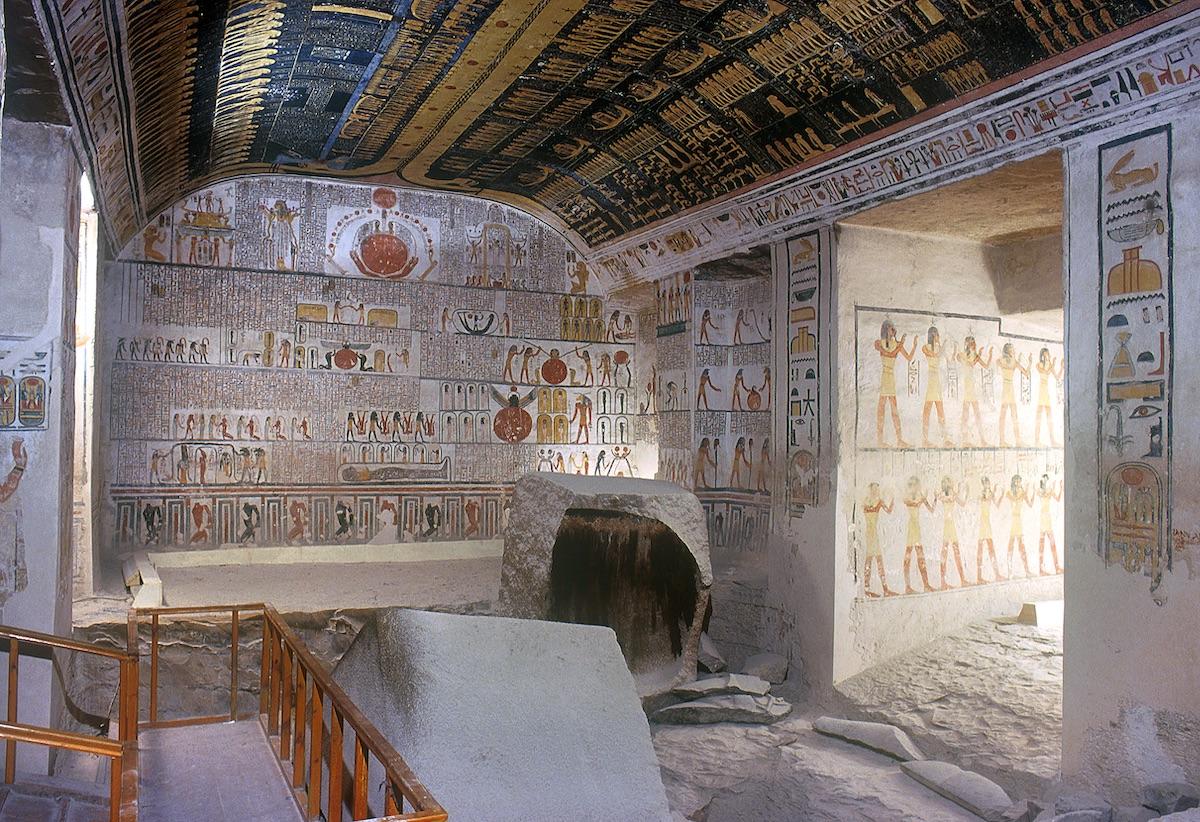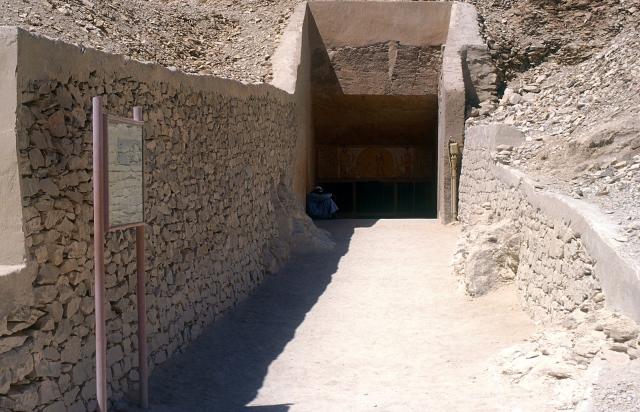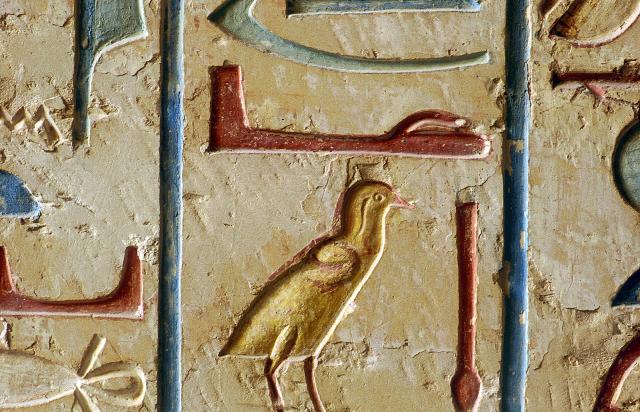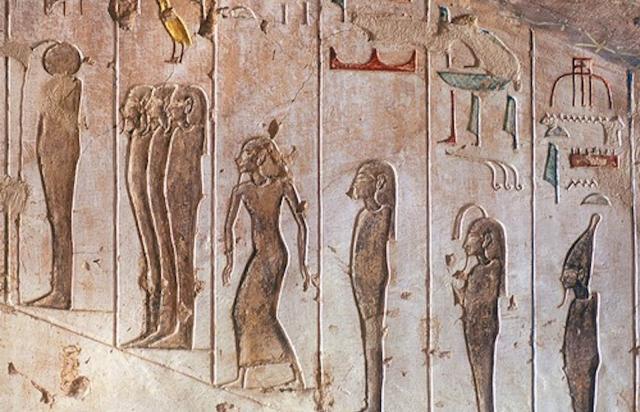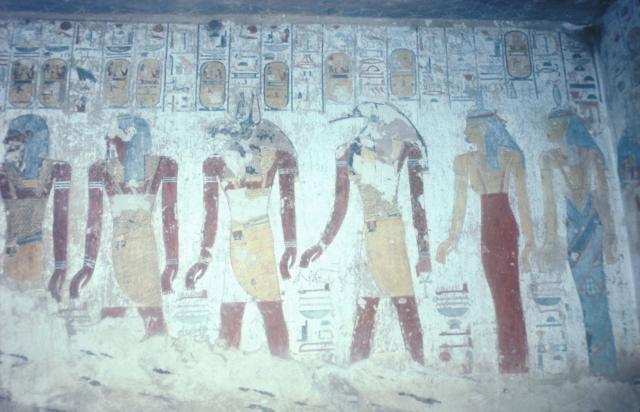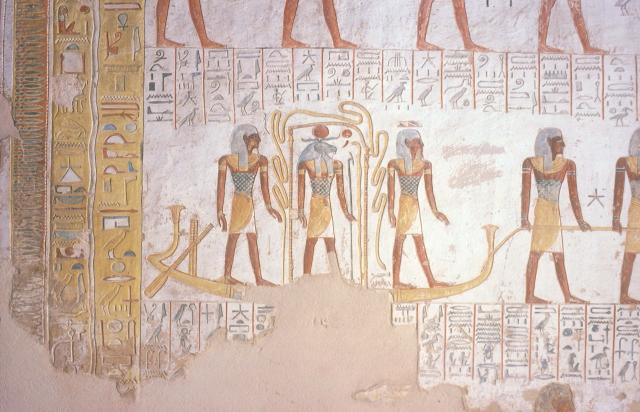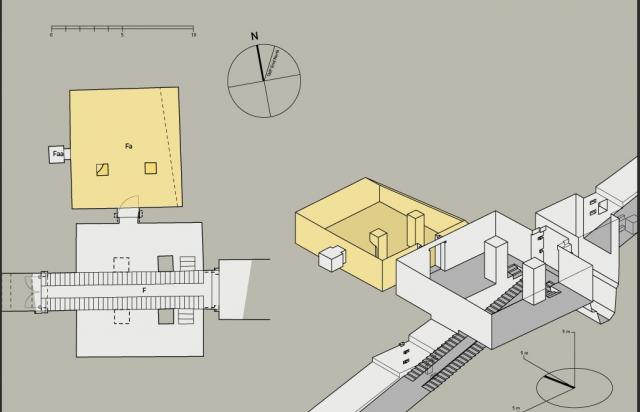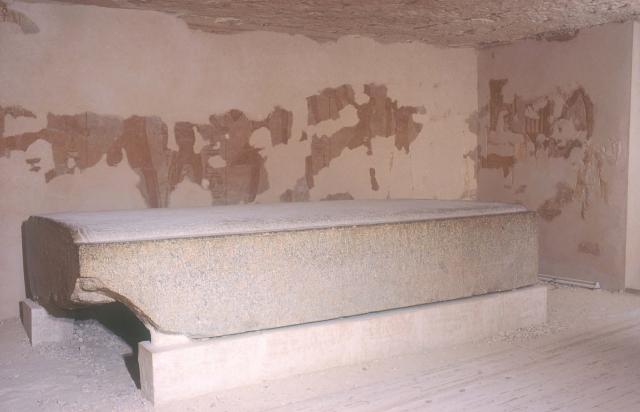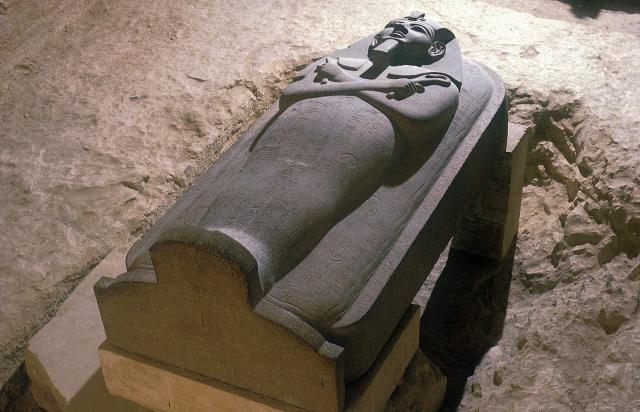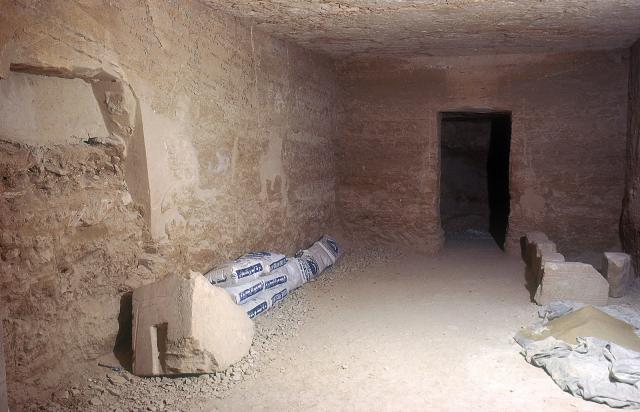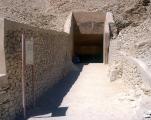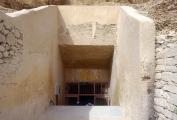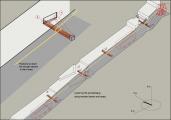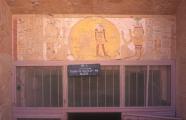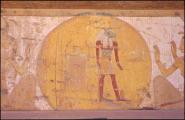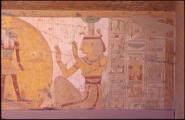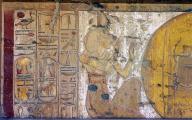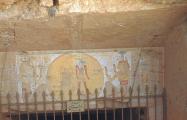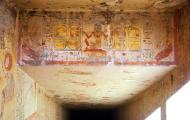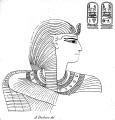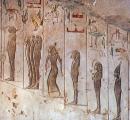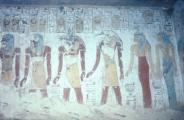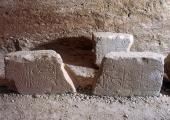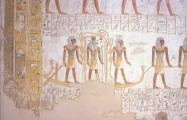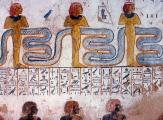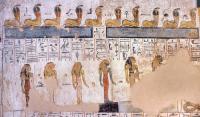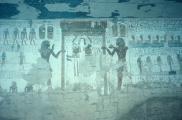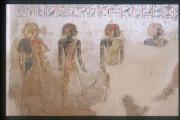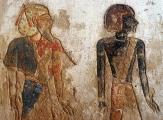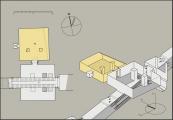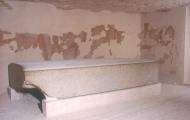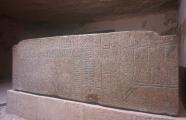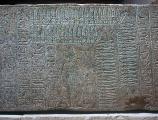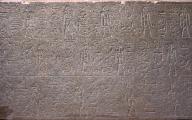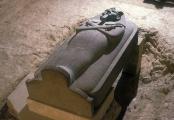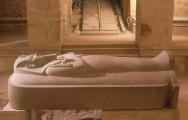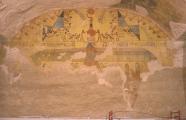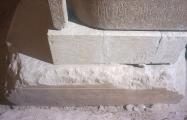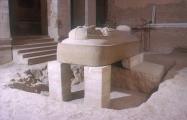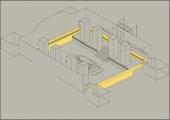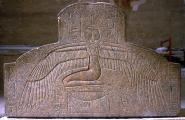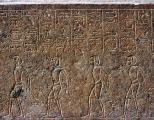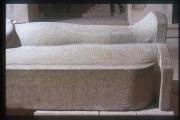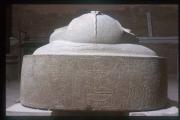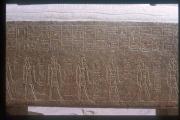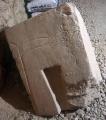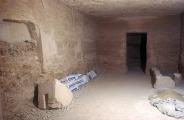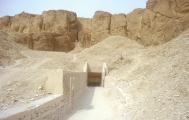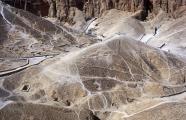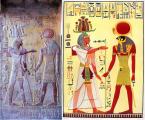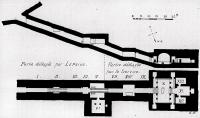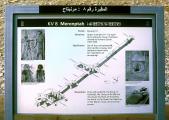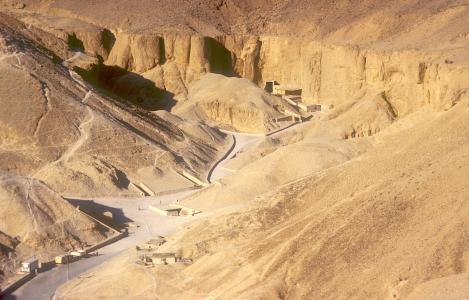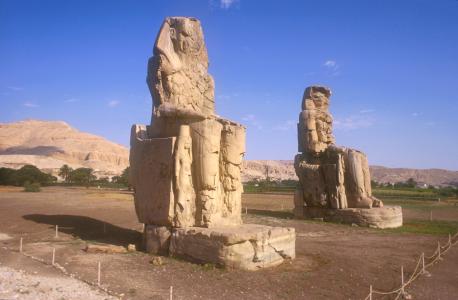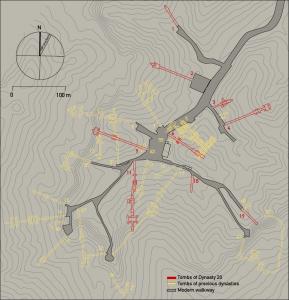KV 08
Merenptah
Entryway A
See entire tombThe stepped open entrance is now covered with a modern stairway that descends to a level landing before gate B. A short cliff overhang covers the gate. Traces of the edges of steps can be seen at the east end of the left (south) side of the entry cuting, indicating that the top of the original stairway was lowered. A pair of beam holes are located near the gate.
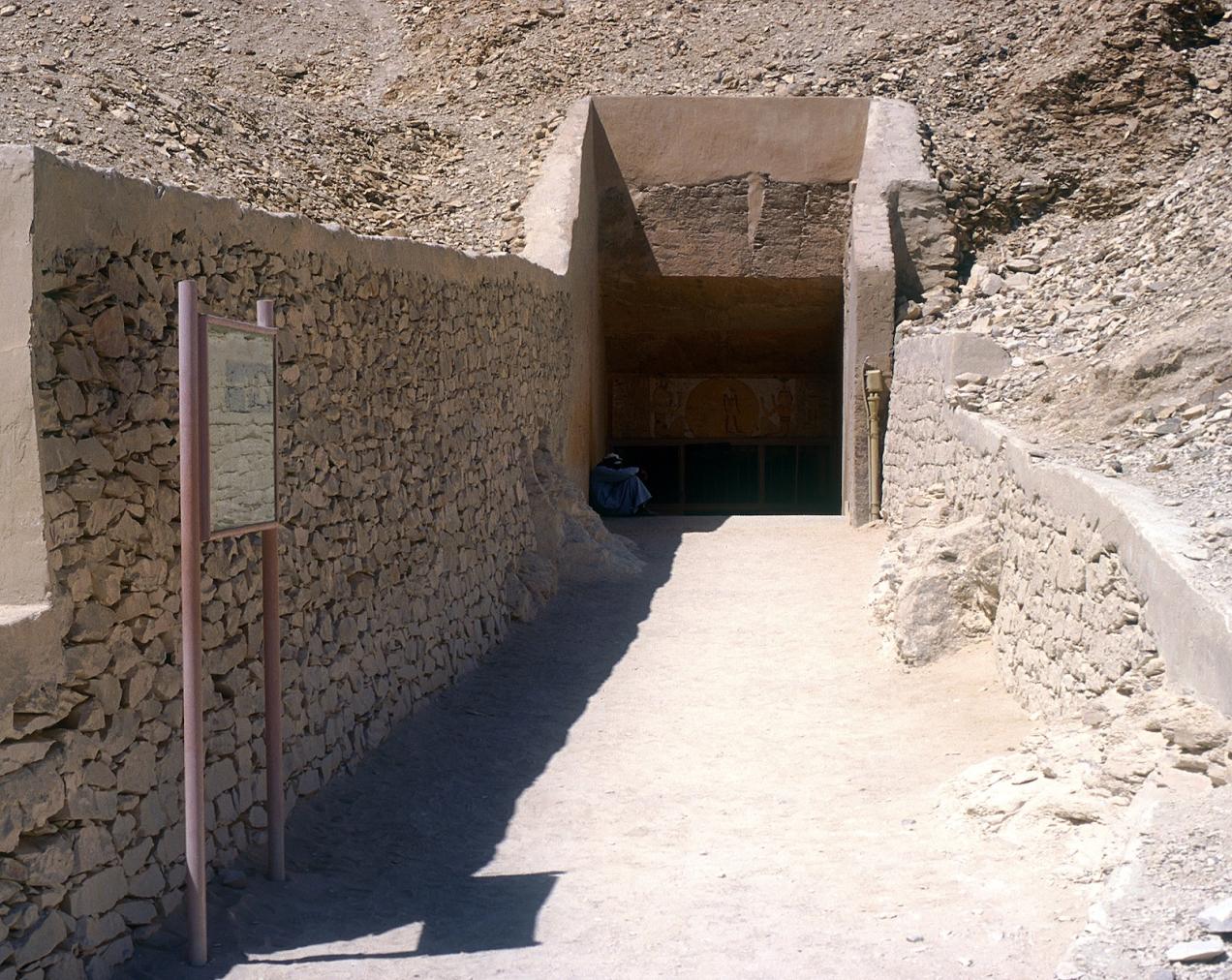
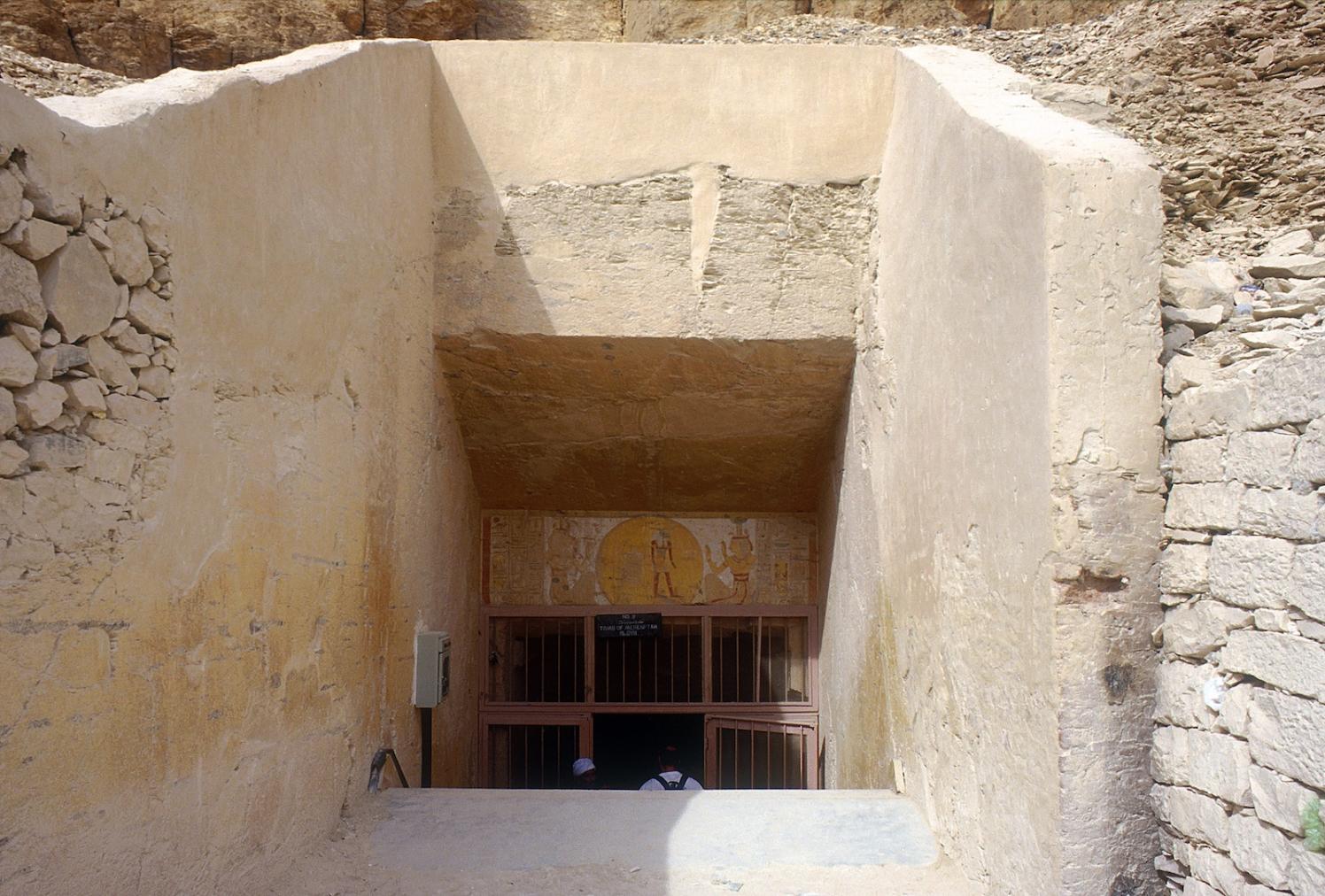
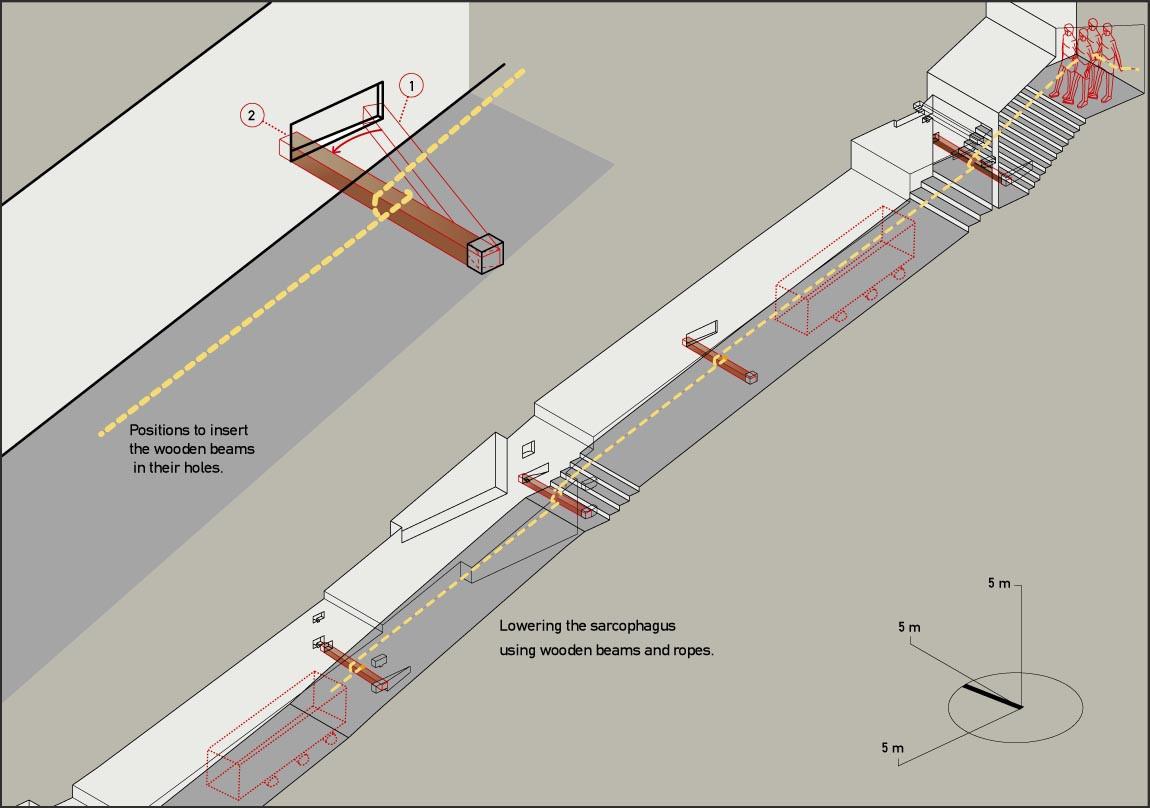
Gate B
See entire tombThe jambs of this gate were cut back, but remains of the original surfaces are visible at the top of the thicknesses. The outer lintel is decorated with a sun disk containing a scarab and a ram-headed god, shown entering the western horizon, and adored by kneeling figures of Isis on the left (south) and Nephthys on the right (north). The reveals are inscribed with the king's names and prayers to Ra and Osiris, partly cut away.
Porter and Moss designation:
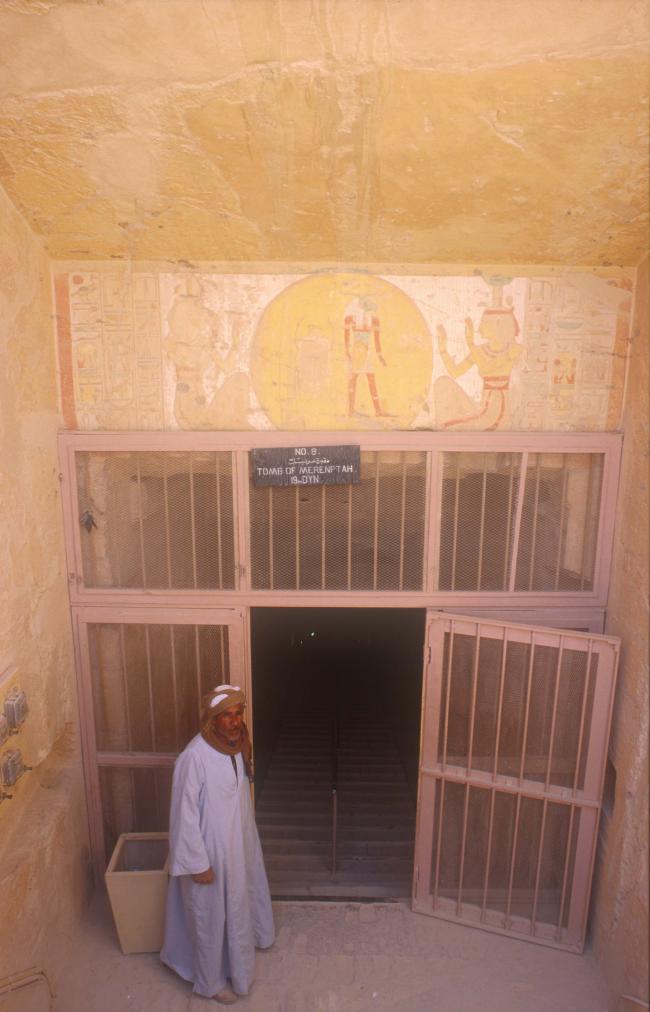
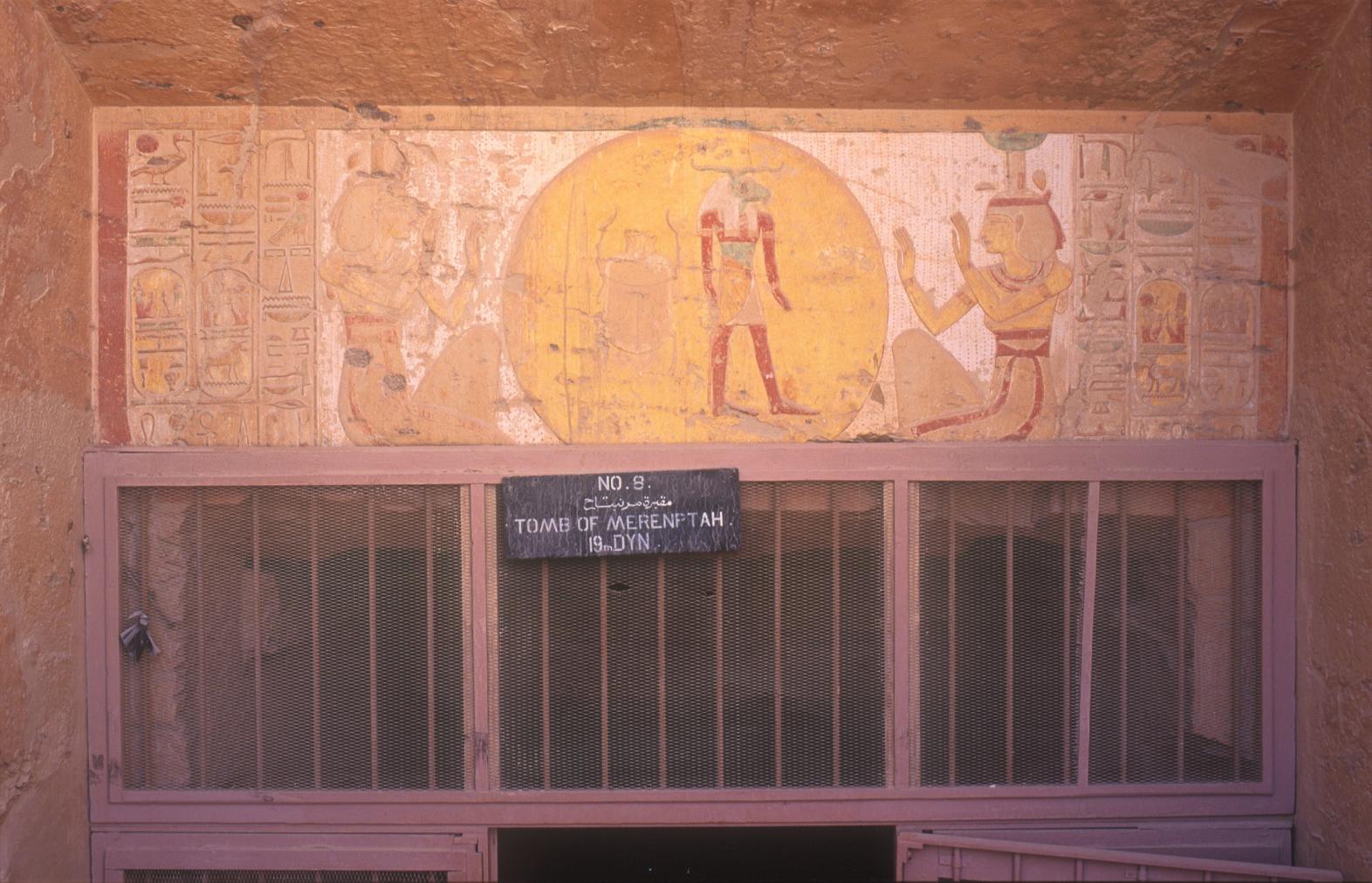

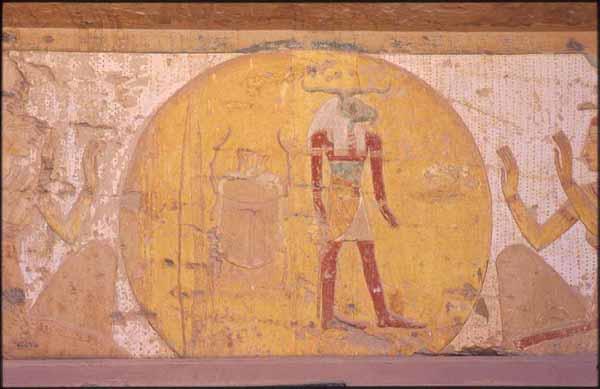
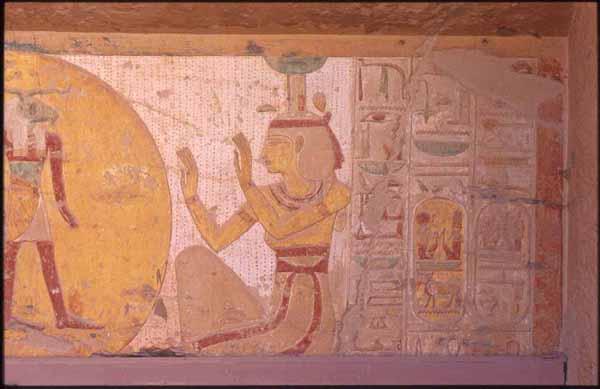
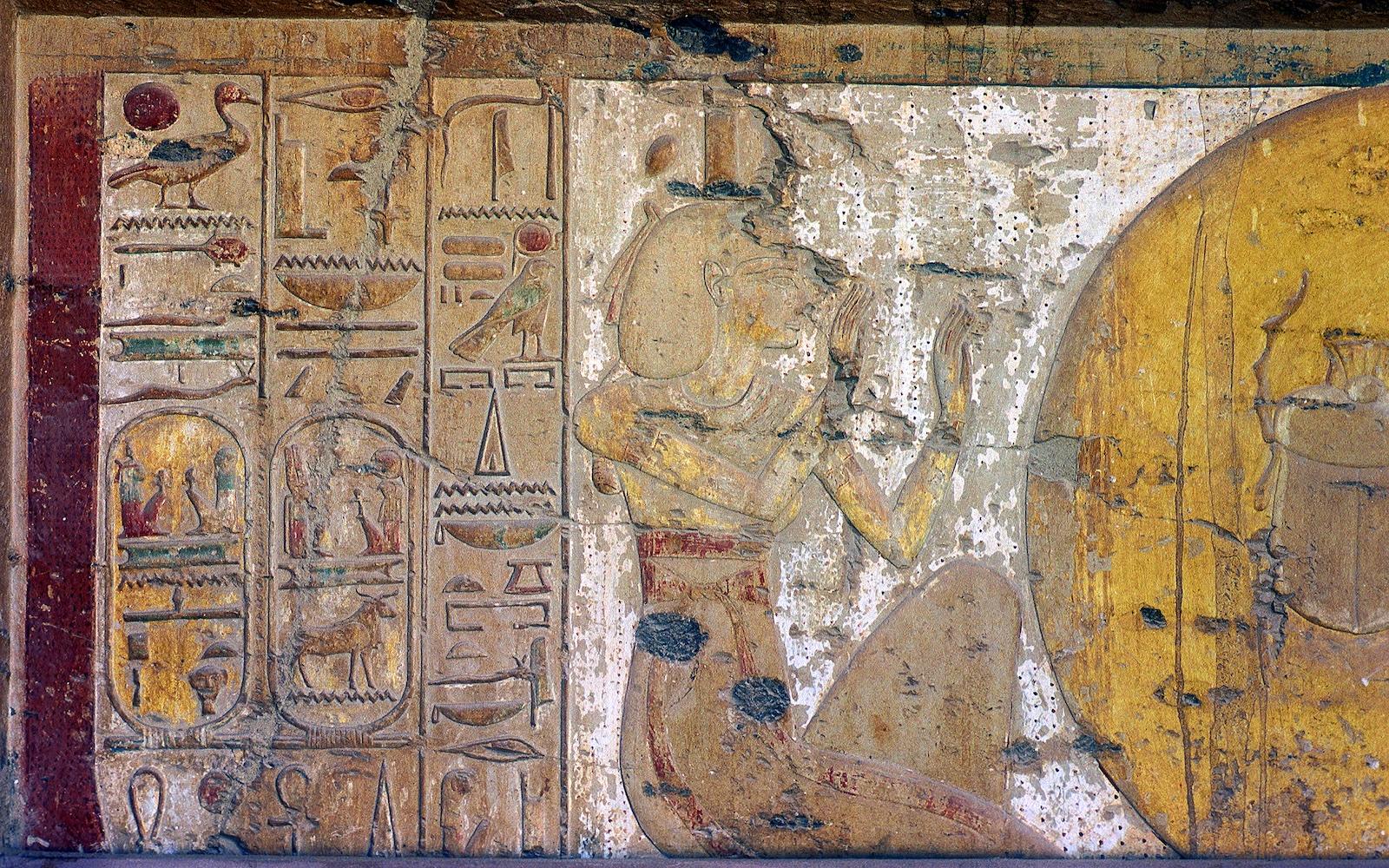
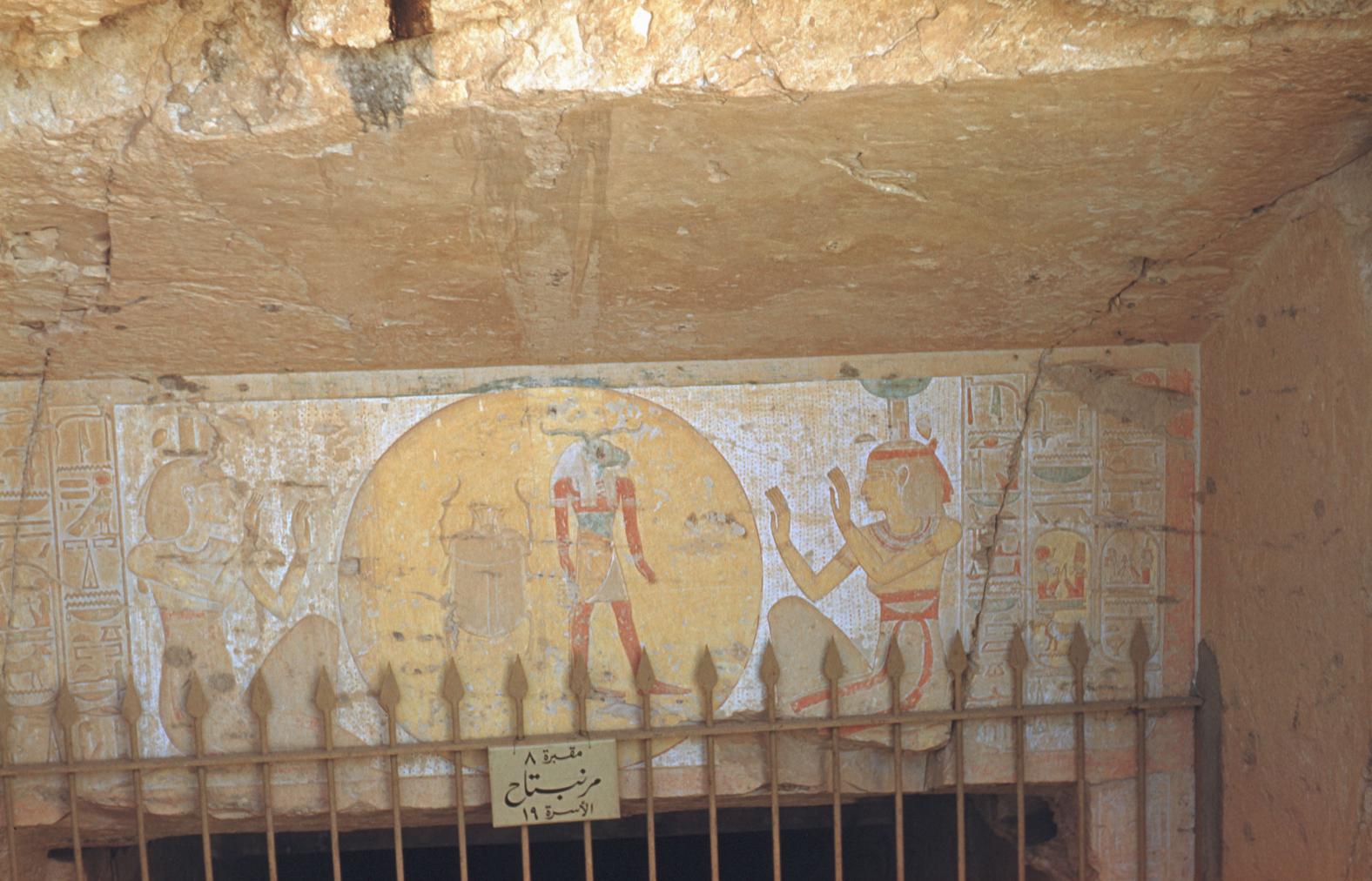
Corridor B
See entire tombModern steps mark the beginning and end of this sloping corridor. A ceiling recess lies at the front of the corridor, and beam holes face each other in opposite walls half way down the corridor. The left (south) wall displays the Litany of Ra, preceded by the king before Ra-Horakhty. The right (north) wall is covered with texts of the Litany of Ra. The scene of the king with Ra-Horakhty, the decoration of the ceiling recess, and the opening vignette of the Litany are in raised relief; the texts of the Litany are in sunk relief. The colors on the walls are well preserved, but some ceiling decoration has been lost.
Porter and Moss designation:
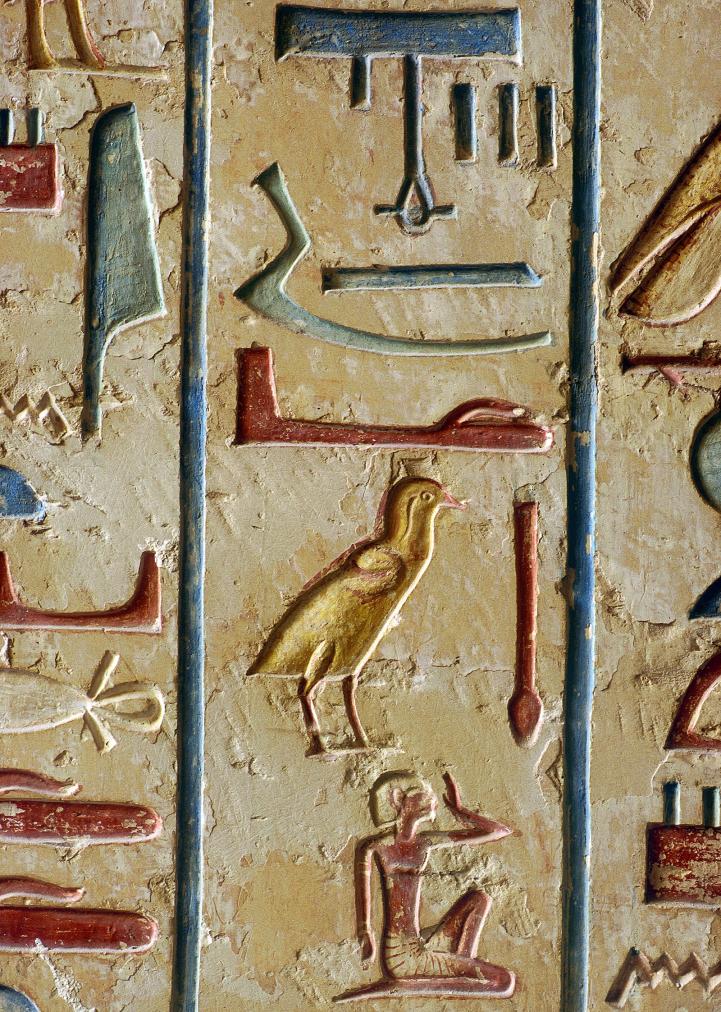
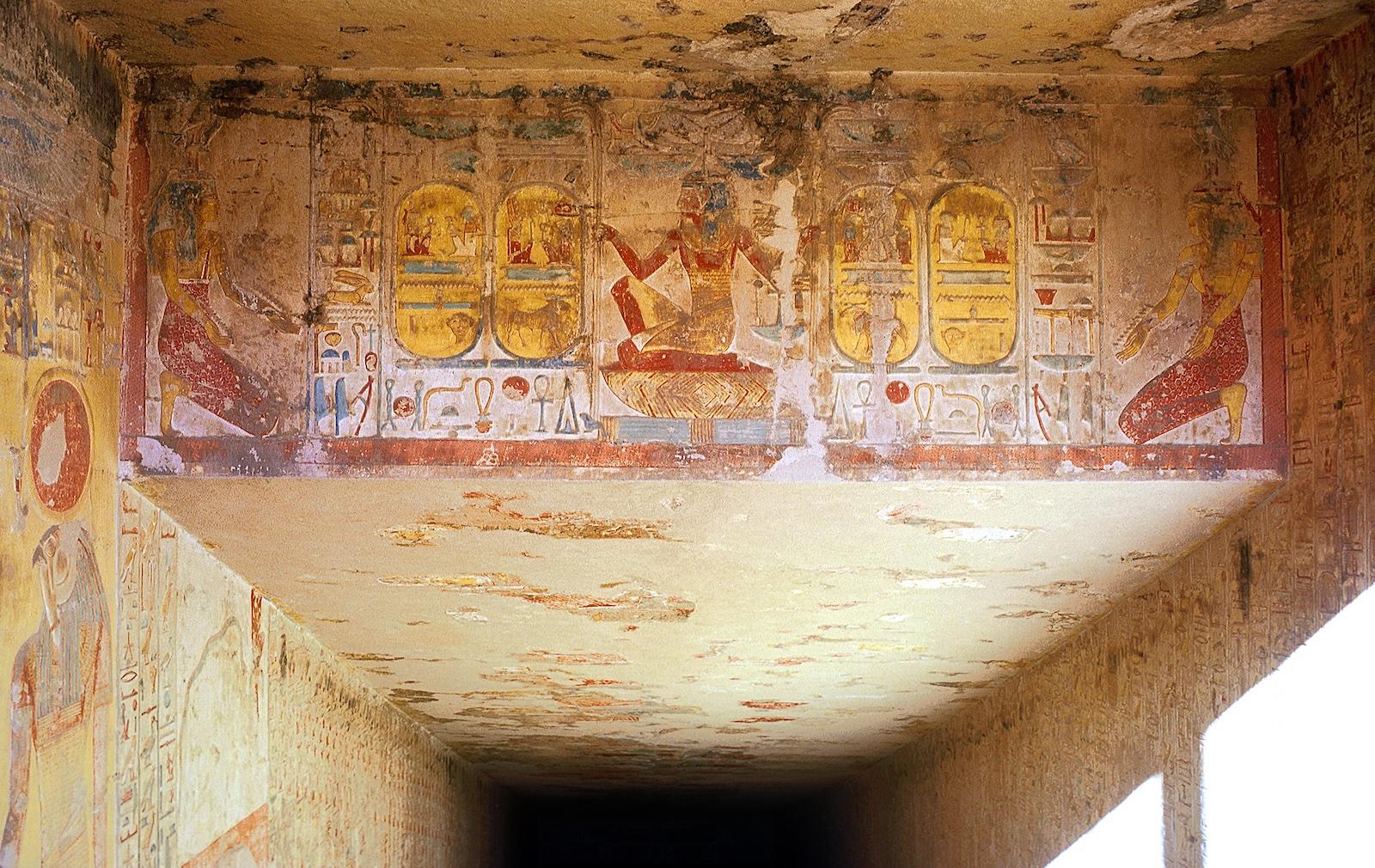
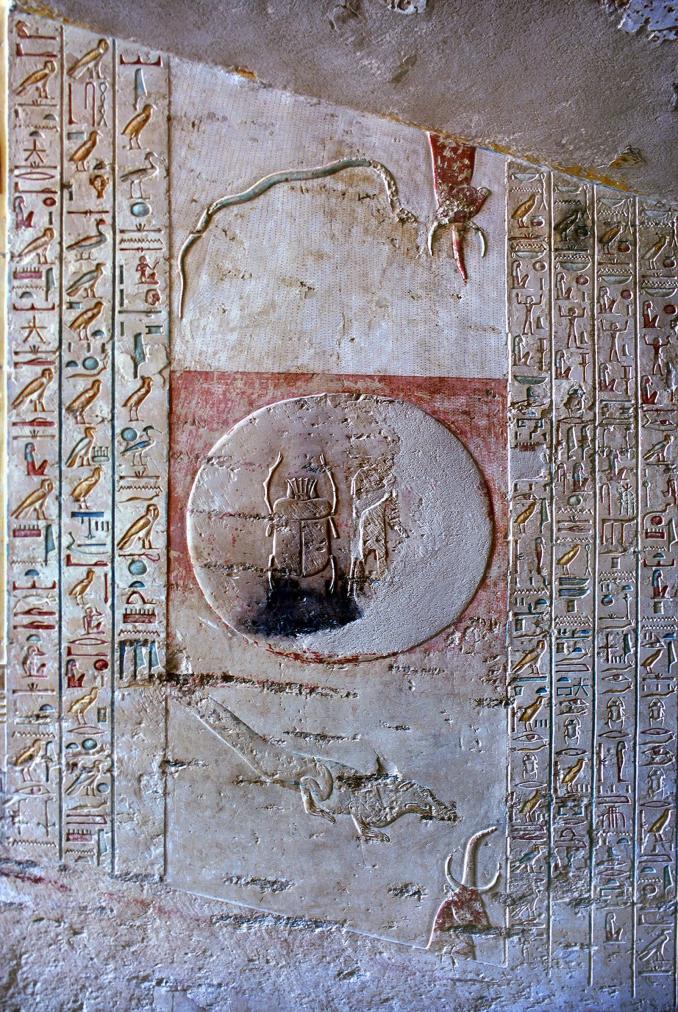

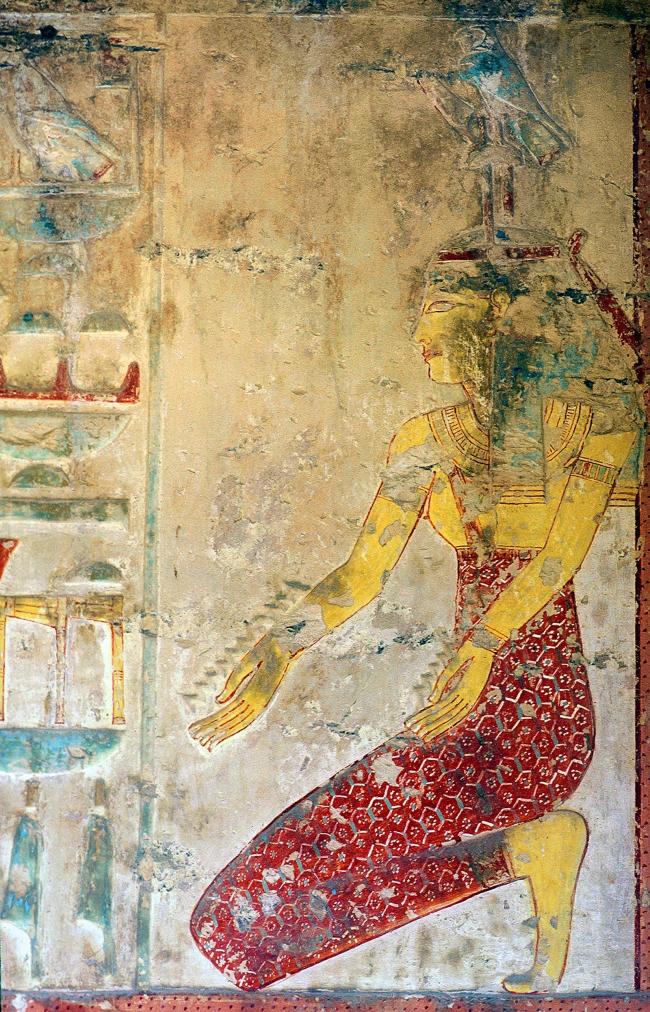
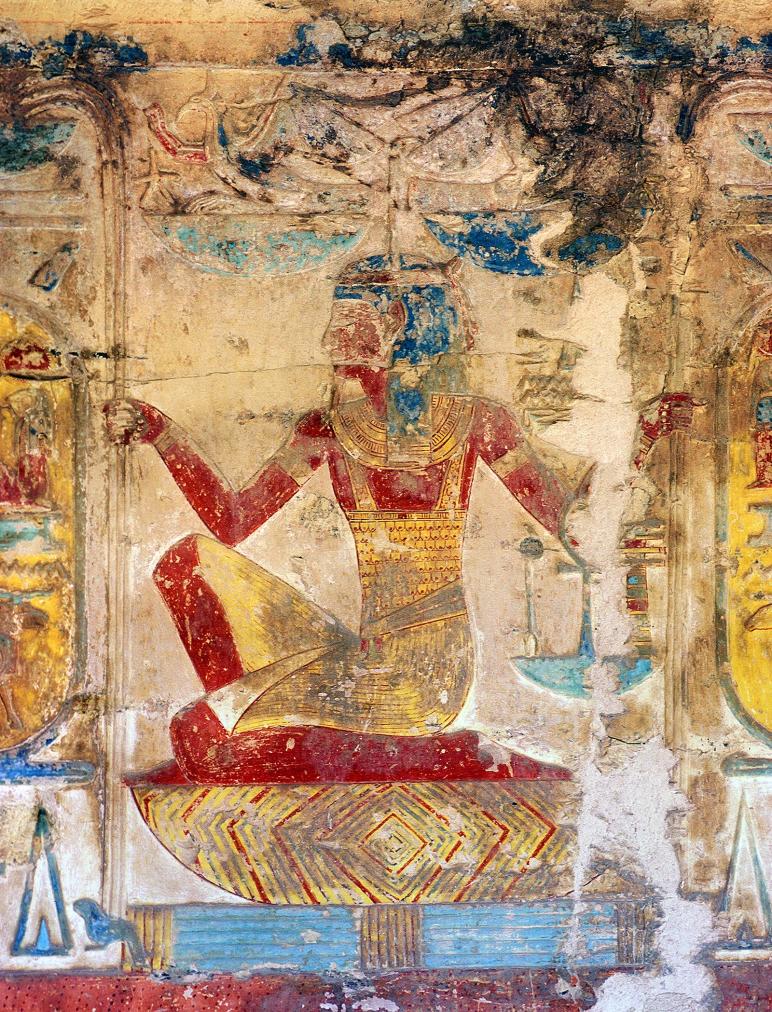
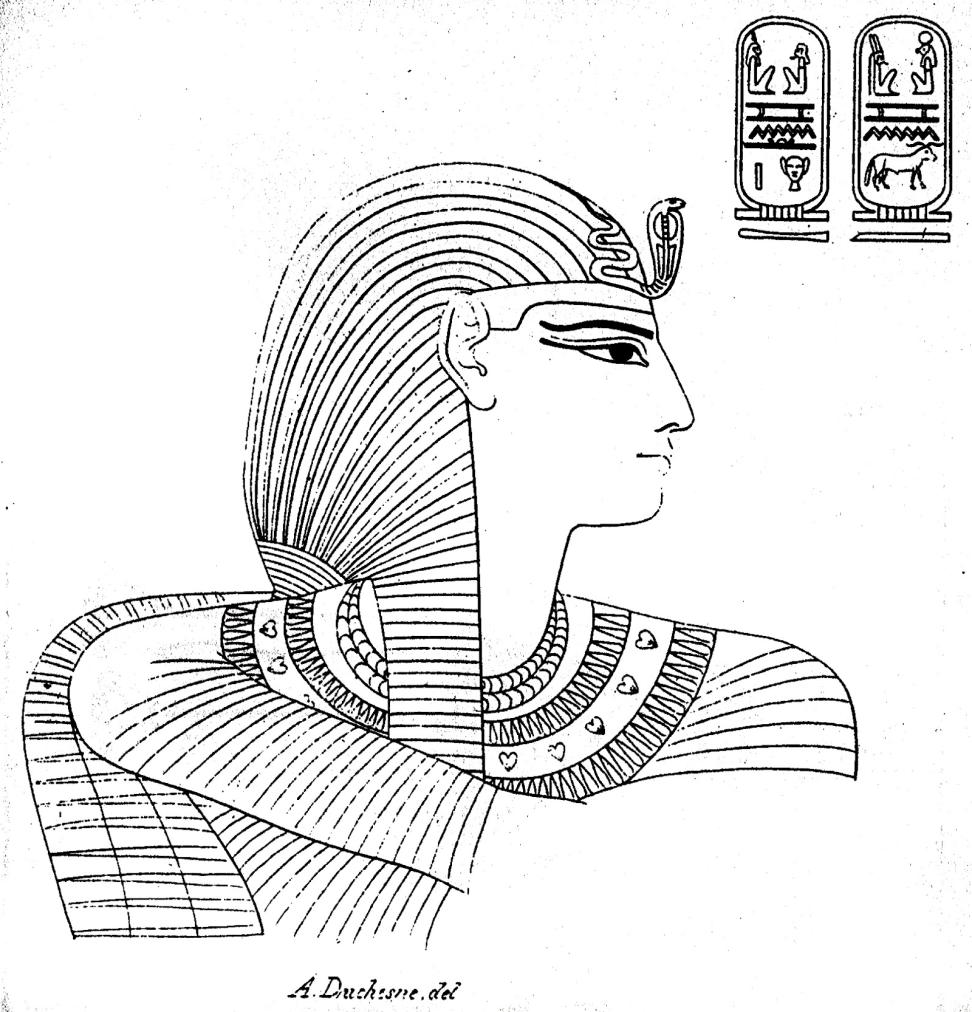
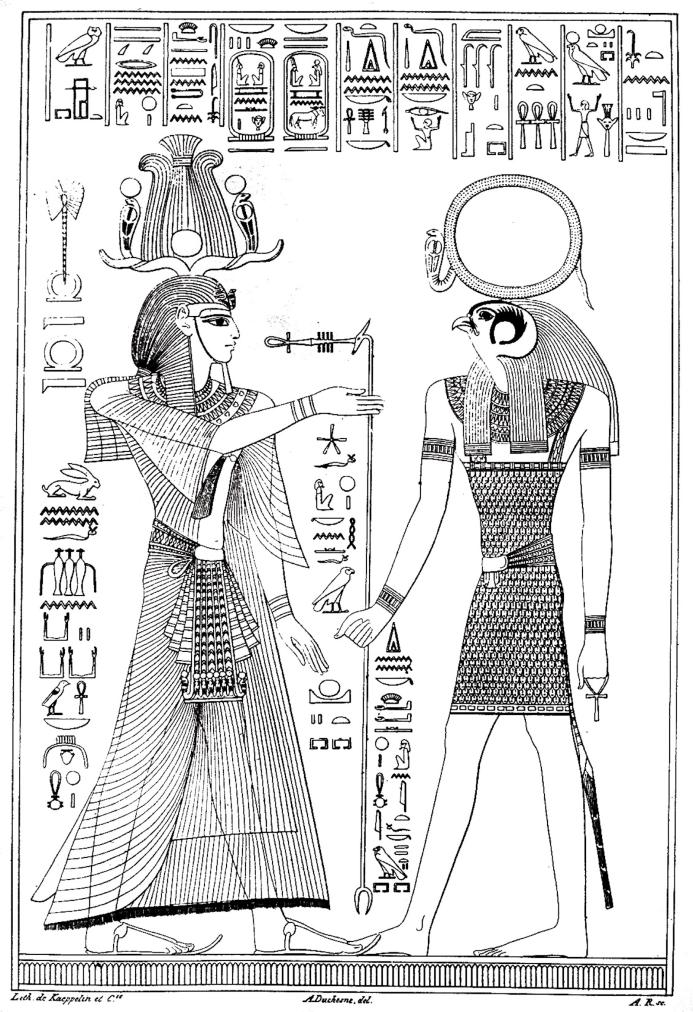
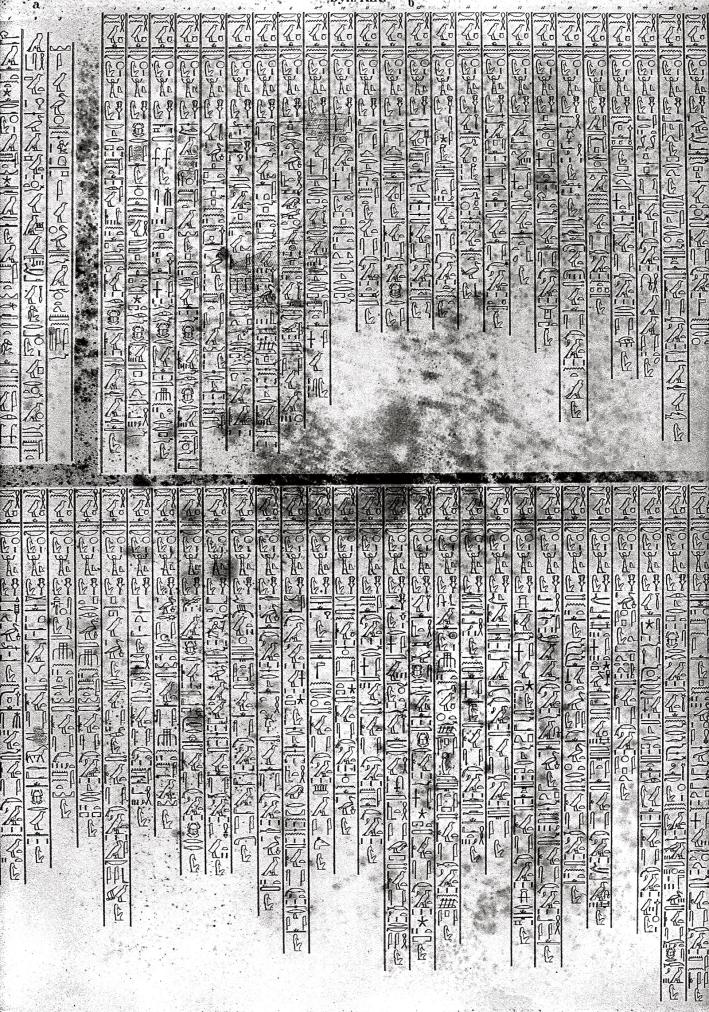
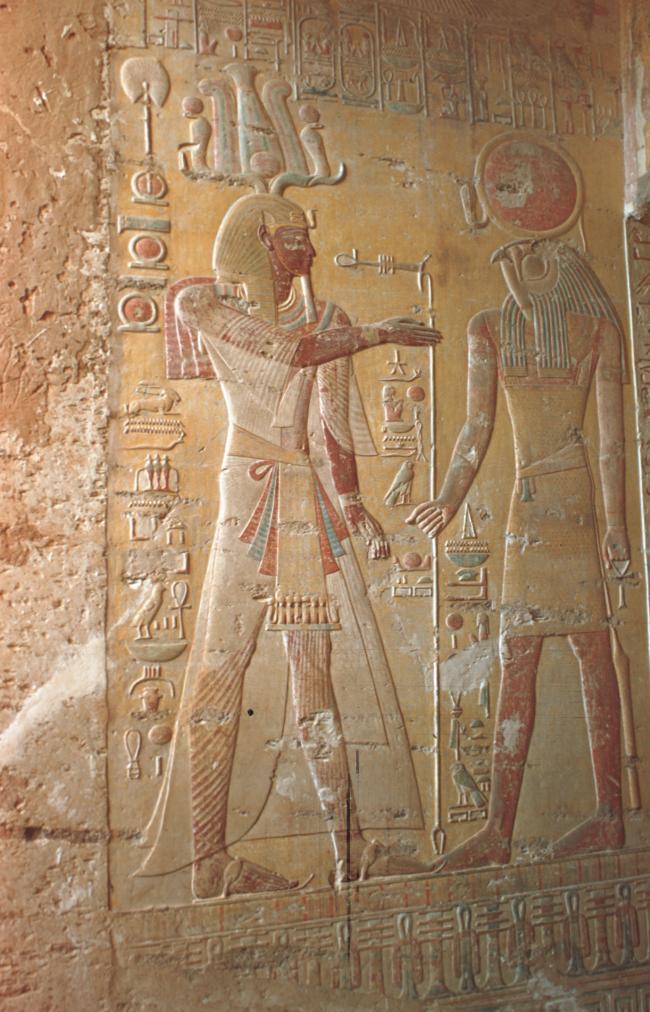
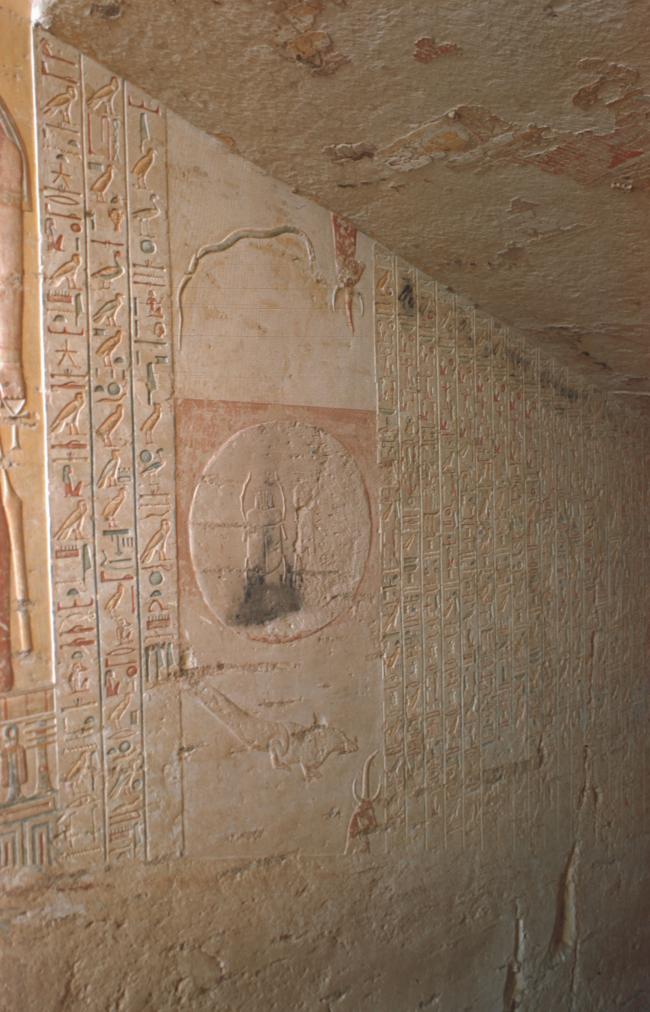
Gate C
See entire tombThe original jambs are cut away. Notches in the thicknesses show how ancient replacements were originally installed. On the lintel is the winged sun disk. The returns are decorated with the Book of Gates, the thicknesses with the Litany of Ra.
Porter and Moss designation:
Corridor C
See entire tombTrapezoidal recesses at the top of the right (north) and left (south) walls extend nearly halfway down the sloping corridor. Gates and texts from the second division (P)/third hour (H) and third division (P)/fourth hour (H) of the Book of Gates decorate the beginnings of the left and right walls respectively. The manifestations of Ra from the Litany of Ra decorate recesses in the upper parts of the left and right walls, and texts of the second and third hours of the Imydwat occupy the space below. Representations of Anubis jackals above Isis and Nephthys kneeling occupy the remainder of the rear (west) parts of these walls. The ceiling is decorated with yellow stars on a blue background. There is a yellow central band with the ba of Ra flanked by Isis and Nephthys as birds at the front (east) end and inscribed with texts from the Litany of Ra.
Porter and Moss designation:
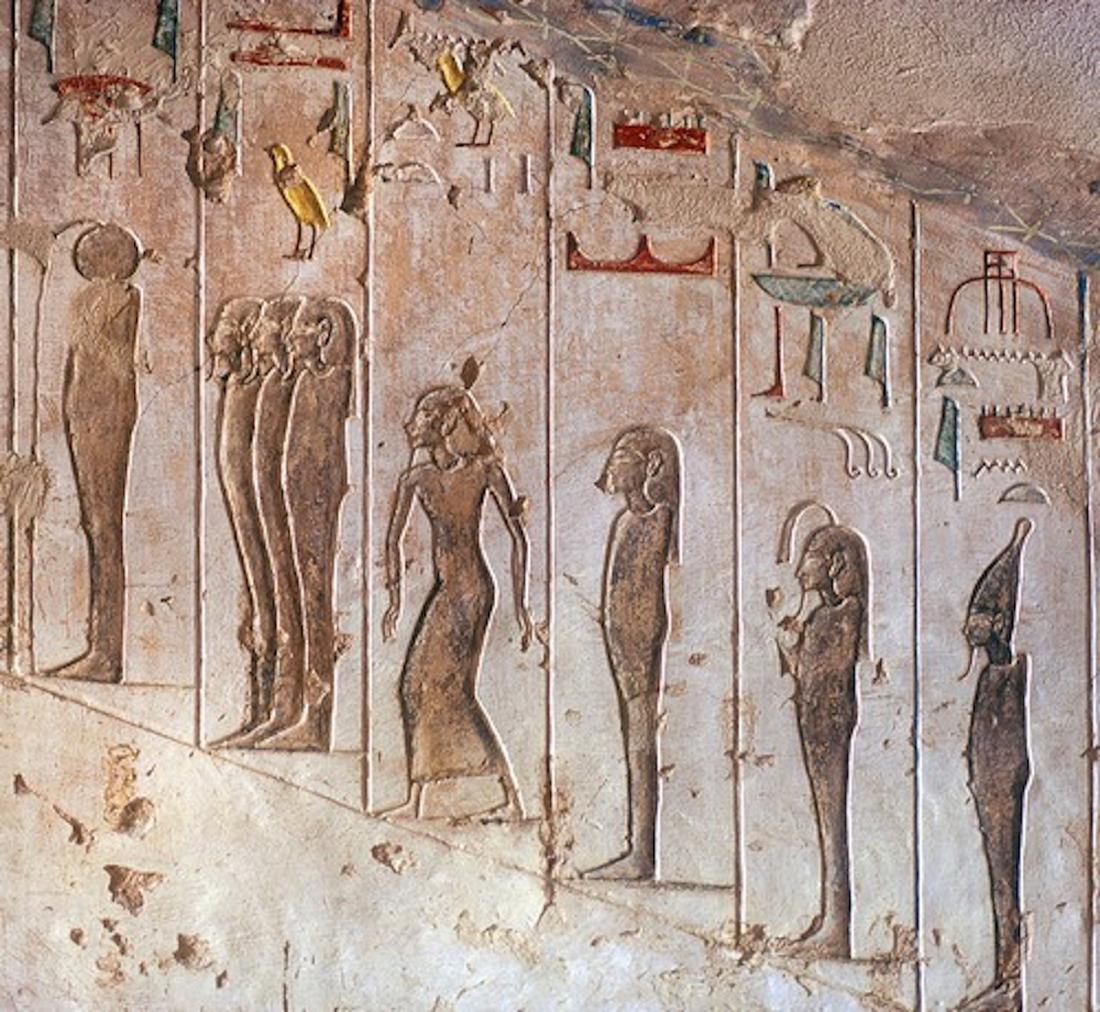

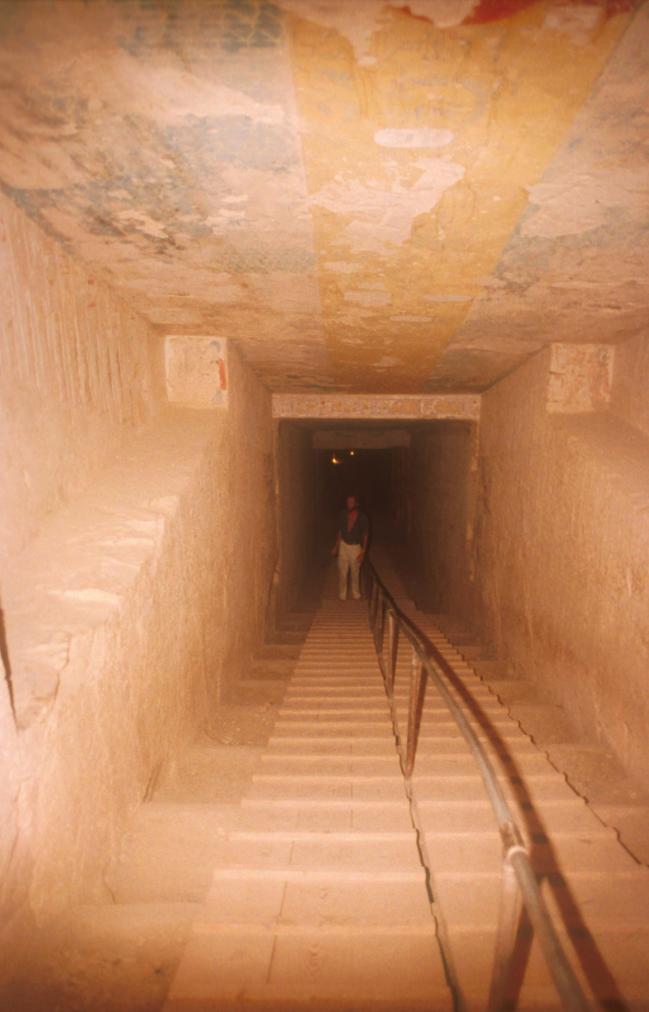
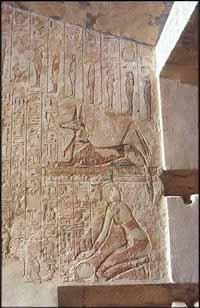
Gate D
See entire tombThe original jambs were cut away to allow passage of the sarcophagi. A pair of rectangular notches, cut into the area of the thicknesses, indicate how the replacement blocks for the jambs were held in place. Cramps were inserted in slots in the bottoms of the notches and the tops of the blocks. Beam holes were cut just in front of the gate. Cartouches decorate the outer lintel.
Porter and Moss designation:
Corridor D
See entire tombA pair of rectangular recesses face each other on either wall before gate E. The left (south) and right (north) walls are covered with the fourth and fifth hours of the Imydwat, respectively. The ceiling is painted blue with yellow stars.
Porter and Moss designation:
Gate E
See entire tombThe outer jambs and thicknesses of this gate are missing. Notches in the thicknesses show how they would originally have been emplaced. The lintel is decorated with the king's names, the thicknesses with the tenth and eleventh hours of the Imydwat.
Porter and Moss designation:
Well chamber E
See entire tombThe floor of this roughly square chamber is occupied by a well shaft. The west wall of the shaft follows a sloping vein of calcite. The left (south) half of the chamber has depictions of Osiris-Wennefer, two Sons of Horus and four deities who face the tomb entrance. Anubis and two Sons of Horus face the tomb interior. The right (north) side of the chamber repeats this scene, but the king as Iwnmutef replaces Anubis.
Porter and Moss designation:
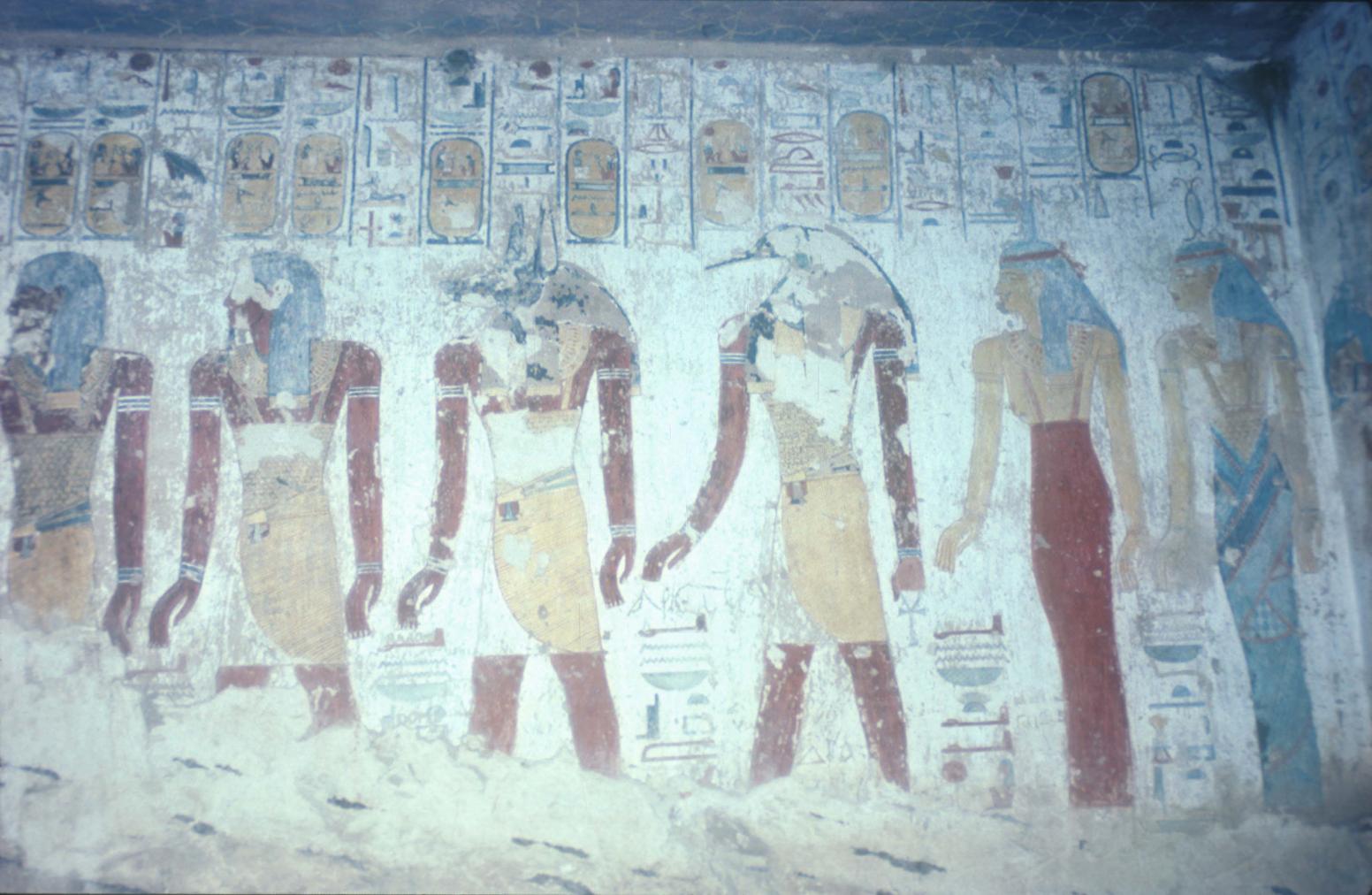
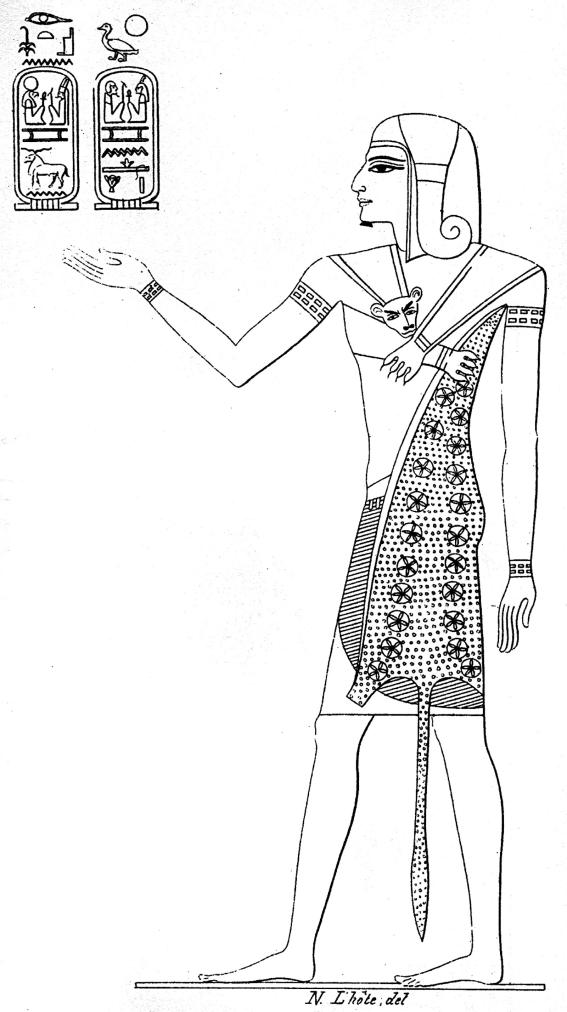
Gate F
See entire tombThe lintel is decorated with a kneeling winged Ma'at. The outer thicknesses of the original compound jambs are missing. In their place, pairs of recesses with slots in the bottoms to receive dovetail cramps held replacement jamb blocks. These blocks and the lintel beam are missing.
Porter and Moss designation:
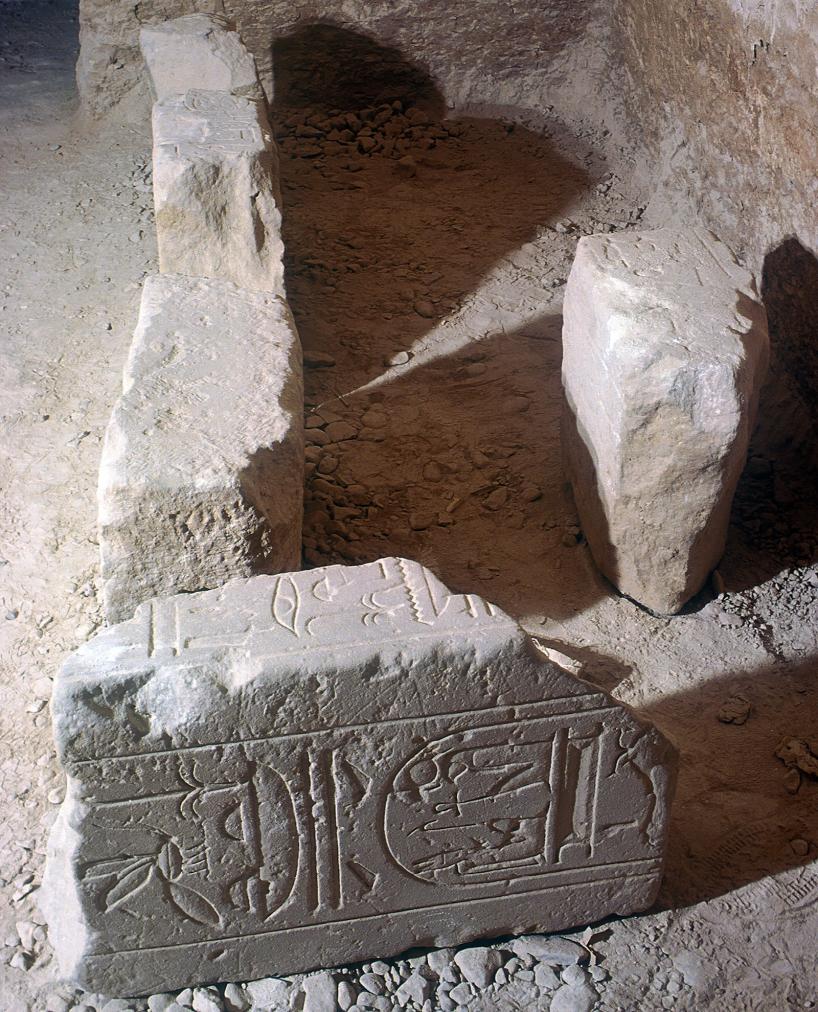
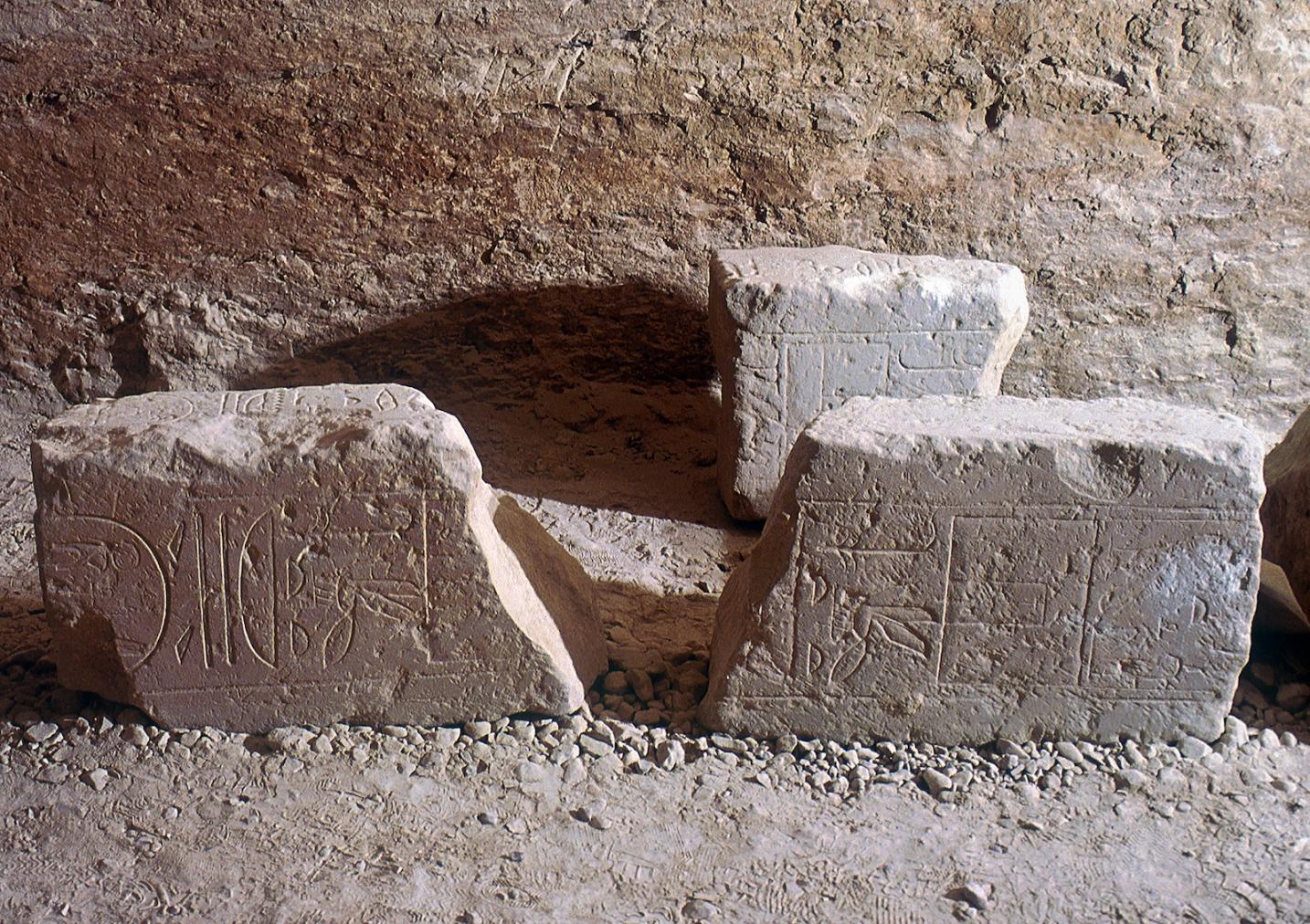
Pillared chamber F
See entire tombTwo pillars flank the central descent, and short flights of steps lead up from either side of the descent to the level floor of this pillared chamber. Traces on the ceiling indicate the original presence of another pair of pillars that flanked the descent. The remains of painted plaster on the ceiling still covering the traces of one of these missing pillars indicates that they were removed before the decoration was completed. The chamber in the right (north) wall leading to side chamber Fa appears to have been cut after that wall was decorated; there are remains of partly preserved figures at the edges of the jambs.
The third, fourth and fifth divisions (P)/fourth, fifth and sixth hours (H) of the Book of Gates form the decorative program of the chamber, together with a double scene of the king offering to Osiris in a shrine, carved on the center of the rear (west) wall above the descent. The two pillars are decorated with scenes of the king making offerings to Osiris, Ptah and Ma'at, standing before Ra-Horakhty and receiving life from Anubis.
Porter and Moss designation:
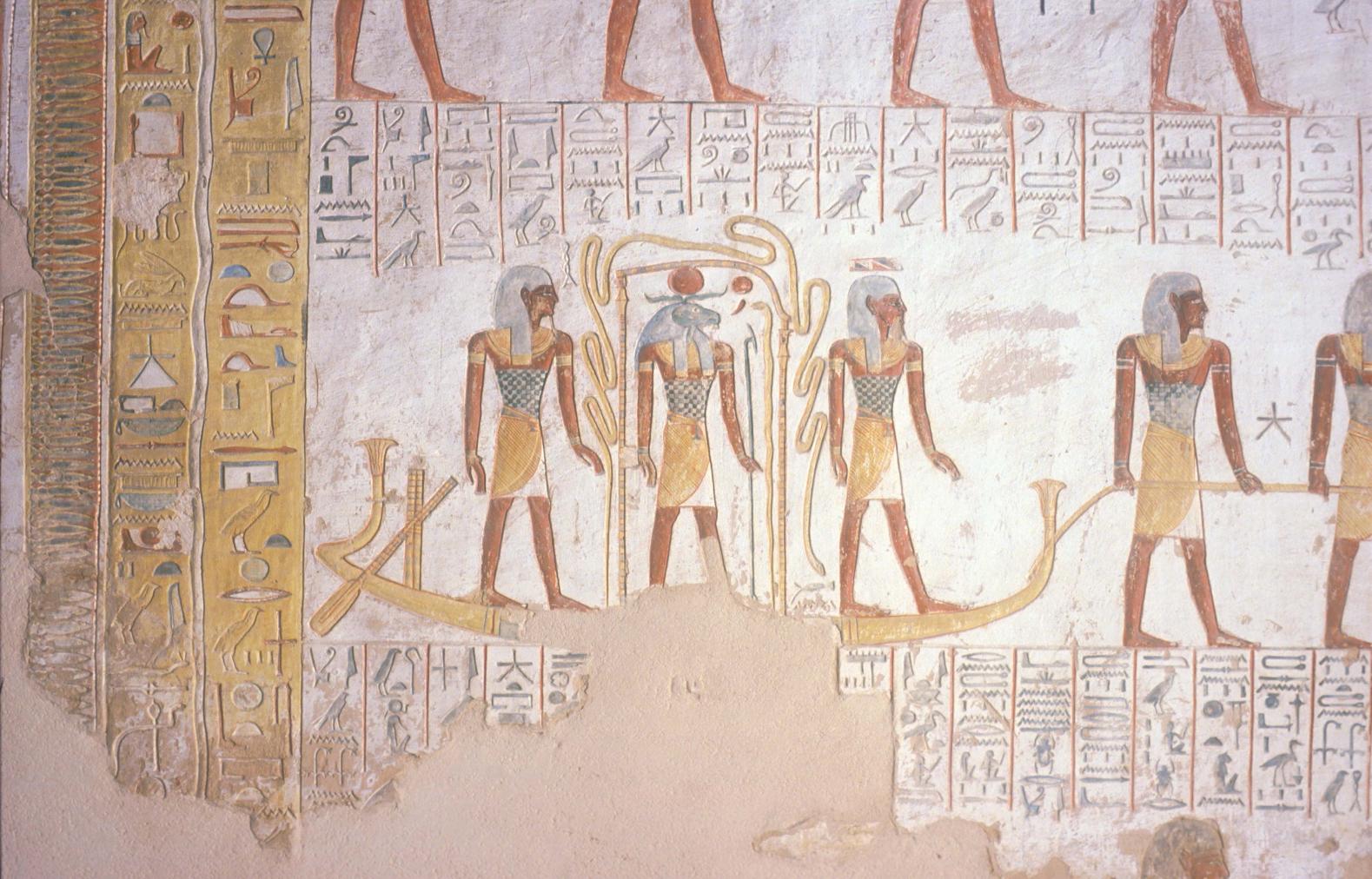
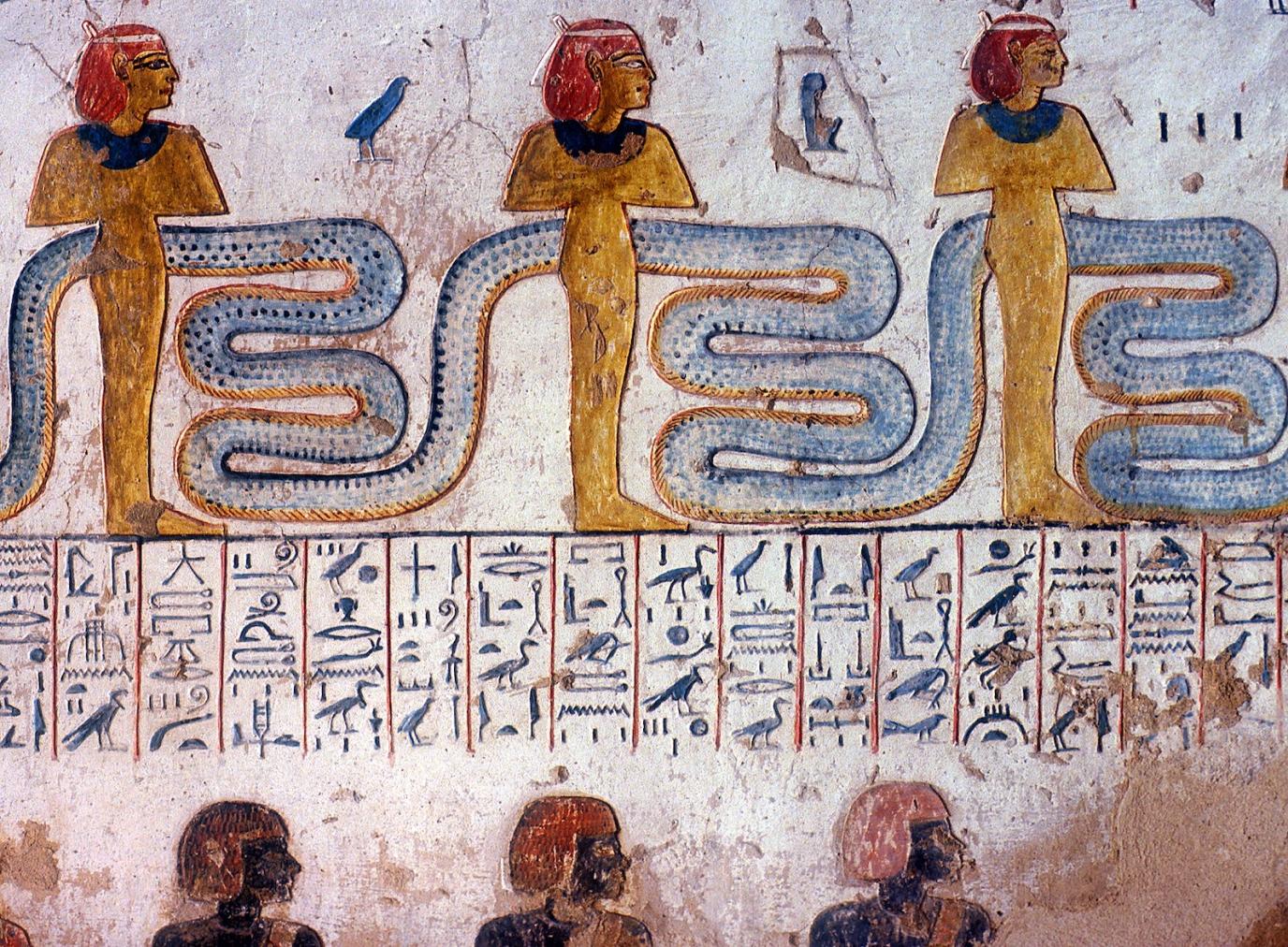
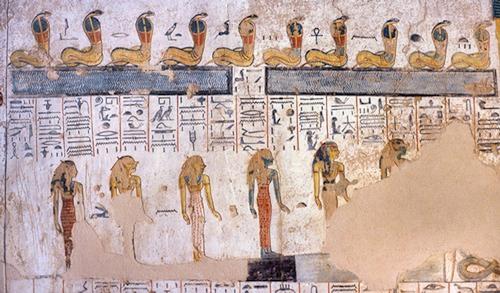
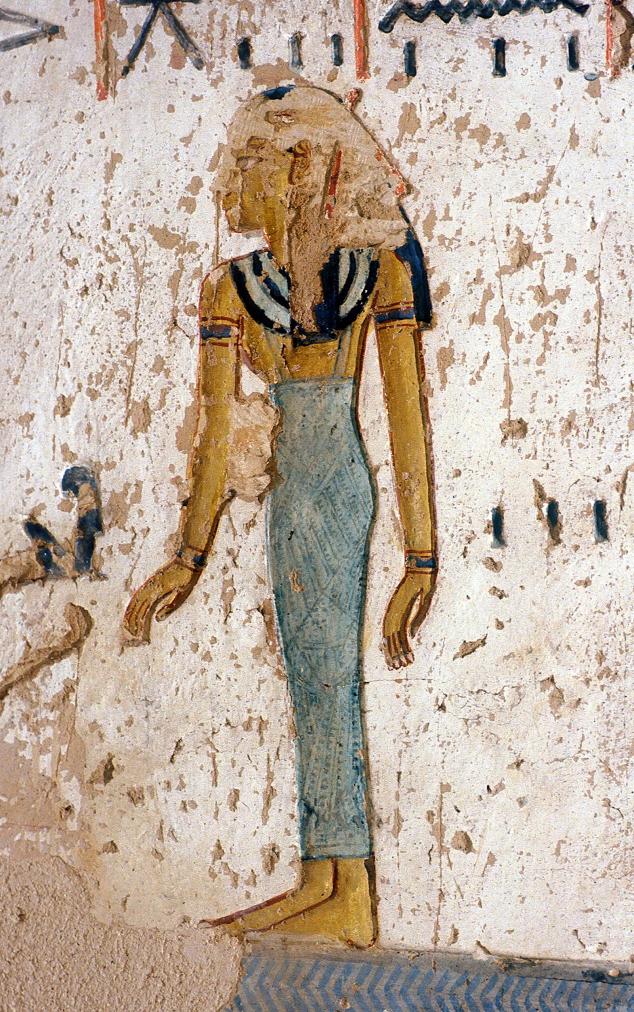
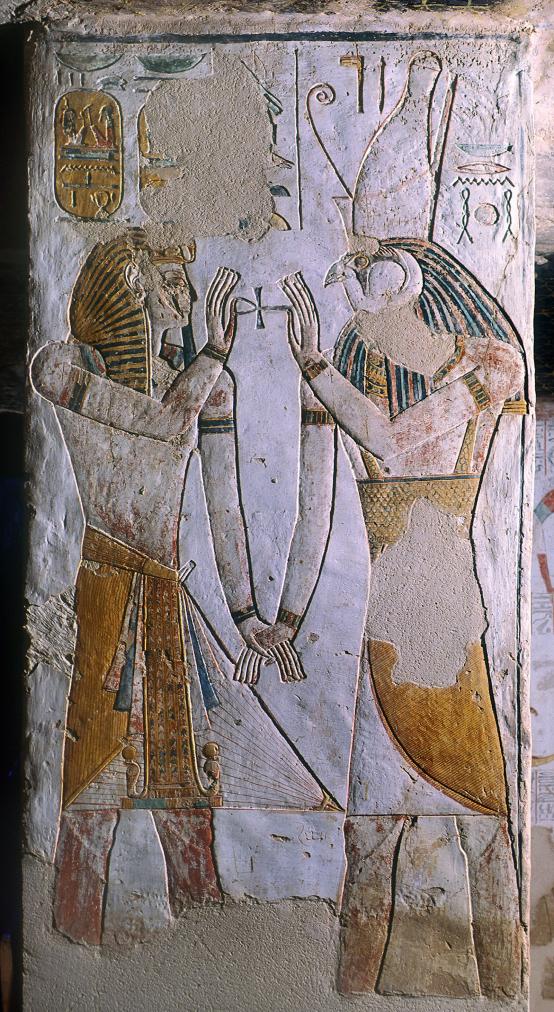
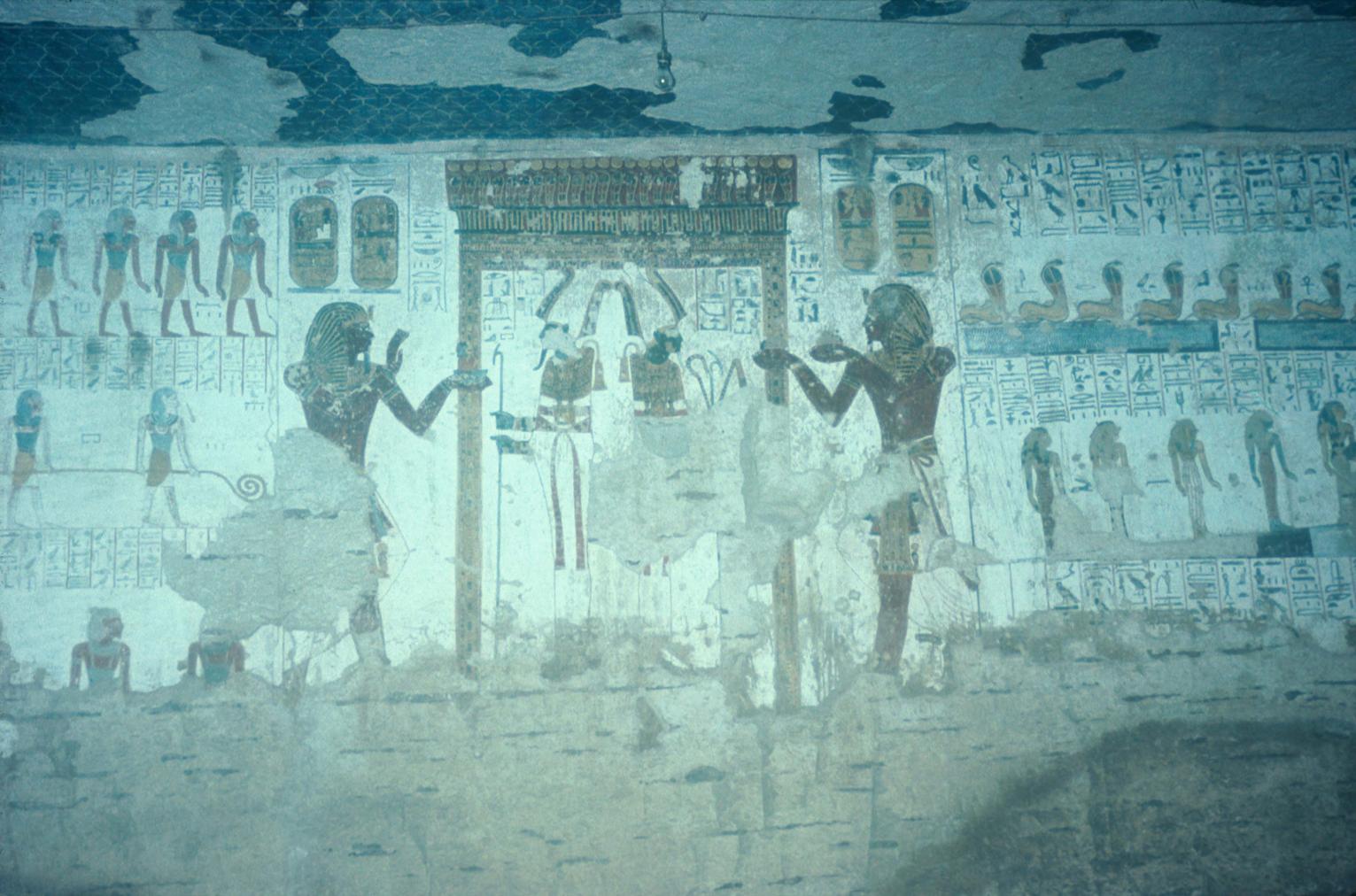
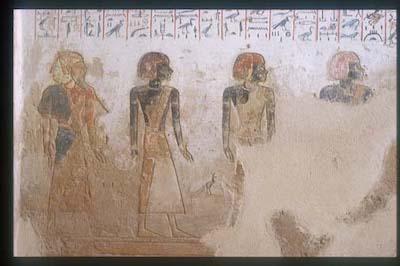
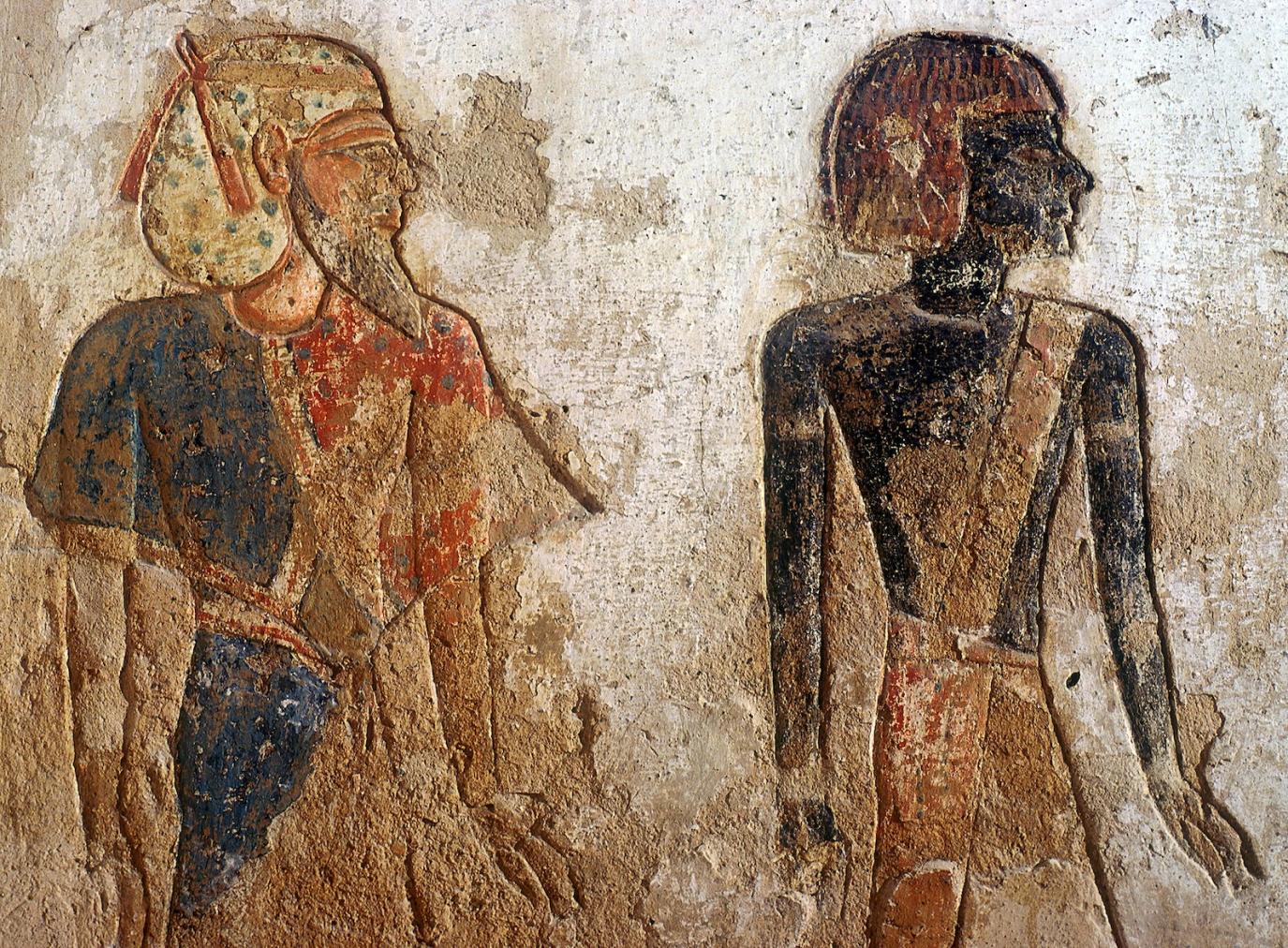
Descent F
See entire tombThe descent consists of a divided stairway with central ramp. It passes beneath an overhang formed by the rear (west) wall of pillared chamber F. The decoration is poorly preserved, and only traces of a few hieroglyphs survive where they had been carved through the missing plaster into the rock surface.
Porter and Moss designation:
Gate Fa
See entire tombThe compound jambs of this undecorated gate are still in place, but the lintel beam has fallen, leaving two holes above the gate where it was situated. There is a door bolt hole in the left (west) jamb.
Porter and Moss designation:
Side chamber Fa
See entire tombThis square side chamber's axis lies perpendicular to the main tomb axis and is reached through a gate in the right (north) wall of pillared chamber F. The chamber has two pillars in the center and a gate in the left (west )wall leads to a small chamber.
Porter and Moss designation:
Side chamber Faa
See entire tombThis small chamber is actually a small shrine to Osiris. It may be an abandoned start for another chamber, or a purpose-cut shrine. The interior surfaces have been plastered and decorated with paint. On either side of the gate, the short interior walls are decorated with cartouches of Rameses II referred to here as the "Osiris-king." Figures of the four Sons of Horus are painted on the left (south) and right (north) walls with Isis and Nephthys, while Osiris is shown on the rear (west) wall accompanied by two goddesses, Qebhyt and Nedjti.
Porter and Moss designation:
Gate Faa
See entire tombThis gate is set well above the floor in the center of the right (west) wall of side chamber Fa. There is no indication that the opening was closed by door leaves.
Porter and Moss designation:
Gate G
See entire tombThe jambs of this gate are missing; notches in the thicknesses show how they would originally have been emplaced. A slot at either side near the top served to hold a wooden lintel beam.The divided stairs of descent F end inside this gate.
Porter and Moss designation:
Corridor G
See entire tombThe corridor has suffered a severe loss of decoration, but enough traces survive, cut through the fallen plaster into the rock surface beneath, to indicate the general decorative program. This consisted of the Opening of the Mouth ritual. It begins on the left (south) wall with a large scale image of the king seated at an offering table before which two priests officiate. The corridor slopes down to chamber H, but levels off before the gate to form a landing.
Porter and Moss designation:
Gate H
See entire tombThe jambs of this gate are missing; notches in the thicknesses show how they would originally have been emplaced. A slot at either side near the top served to hold a wooden lintel beam. The gate has compound jambs.
Porter and Moss designation:
Chamber H
See entire tombOn the right (north) side of this level, roughly square chamber lies the rectangular lid of the outer sarcophagus of Merenptah. This was moved here after the burial was dismantled, and the third sarcophagus was taken to Tanis. The plaster walls have deteriorated, but in the right half of the chamber, representations of the king and deities are still visible. The king is shown addressing the forty-two assessors in the judgment hall of Osiris, and the "Negative Confession" (or denial of sins) from the Book of the Dead, spell 125 was painted on the walls of the left (south) half of the chamber. In front of gate I, the floor of H was cut down to a sloping ramp leading through the gate into corridor I.
Porter and Moss designation:
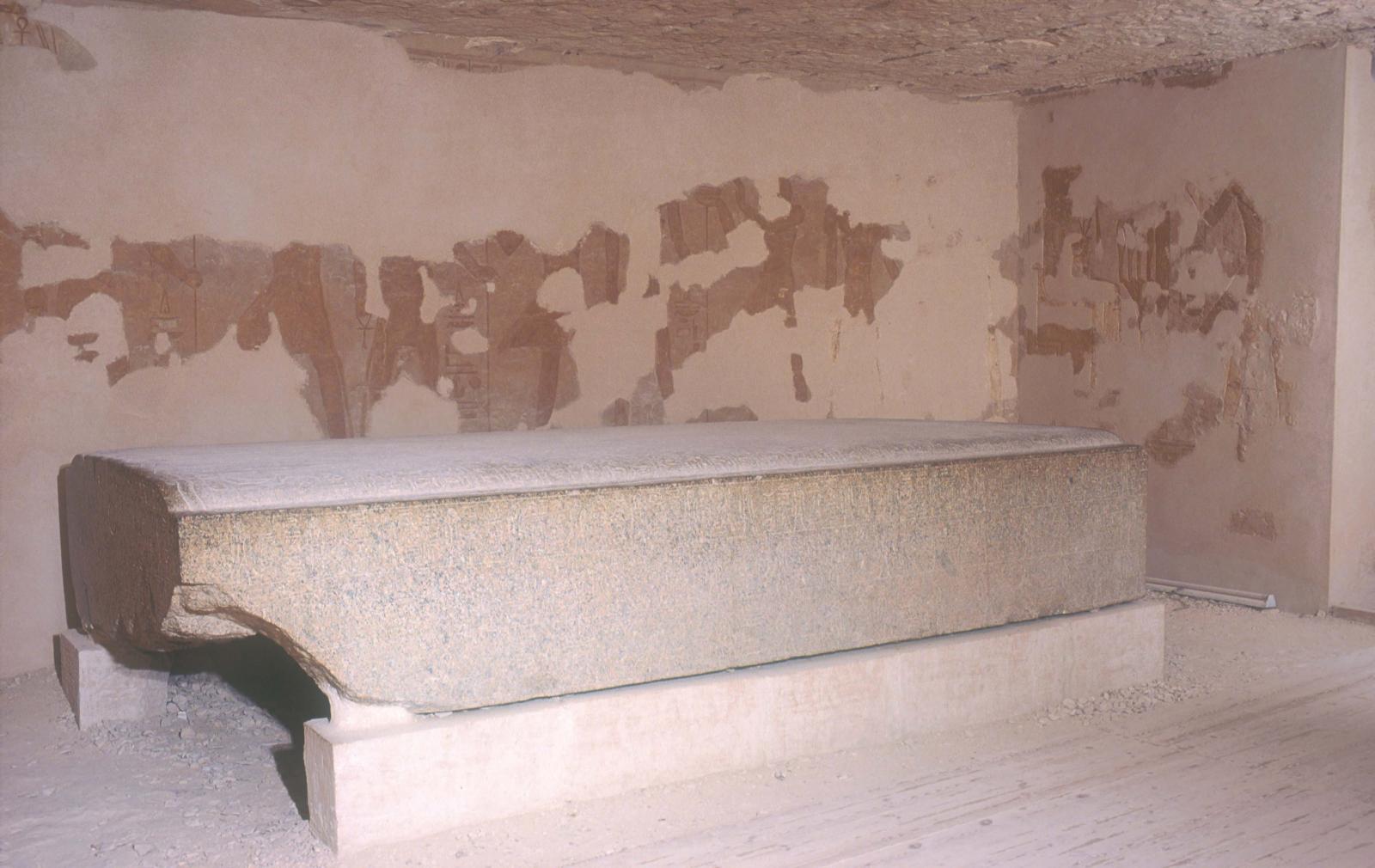
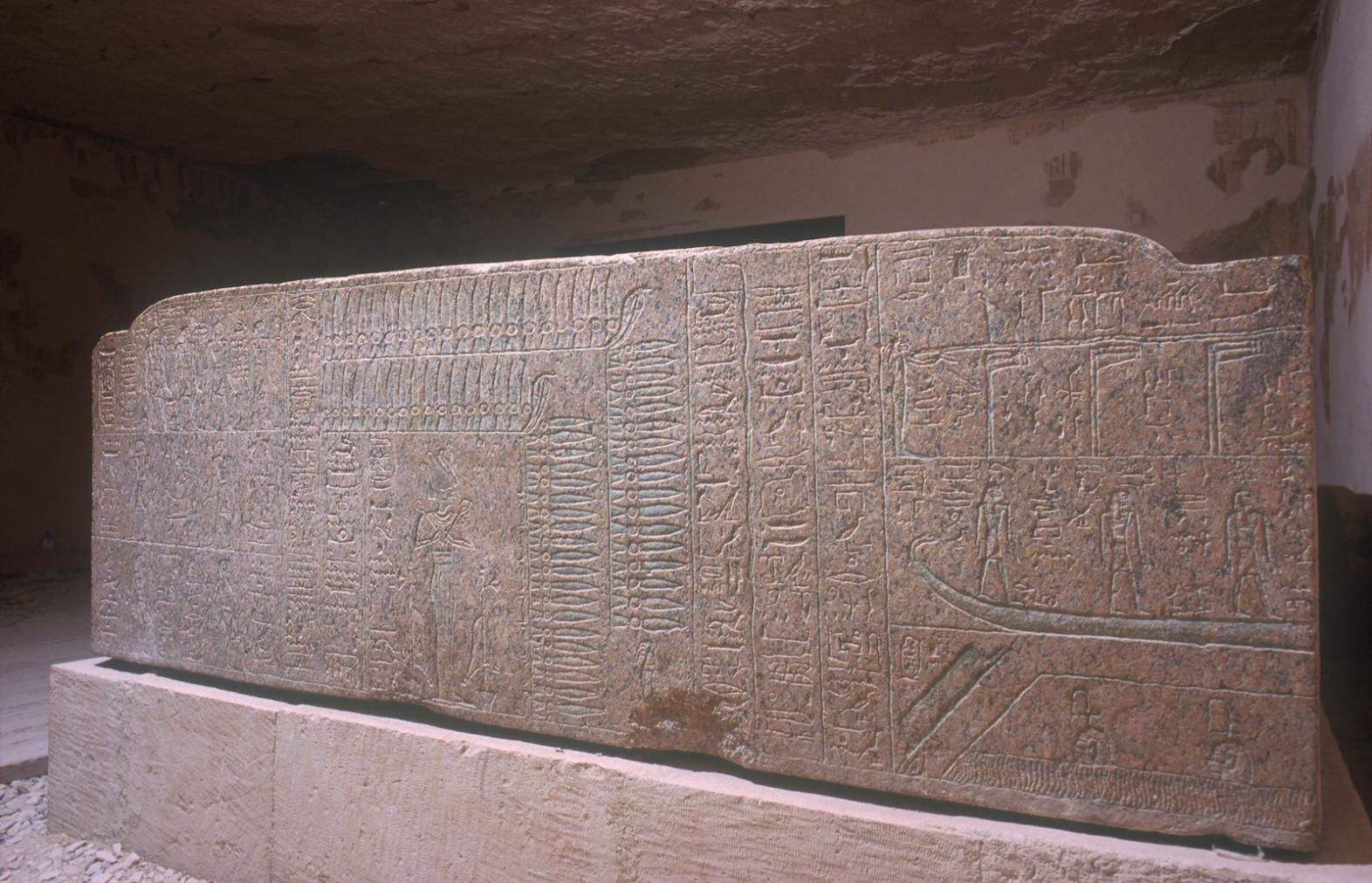
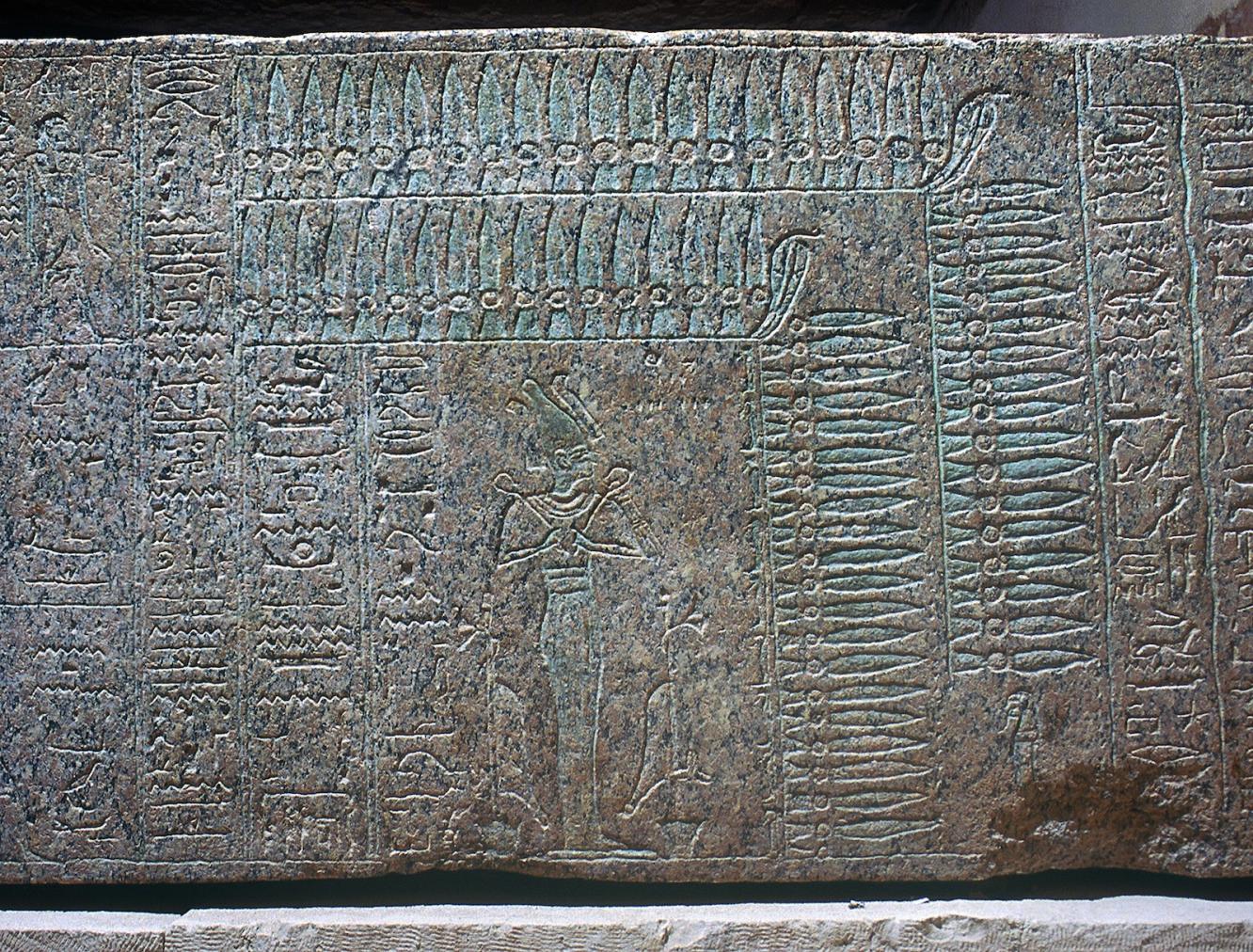
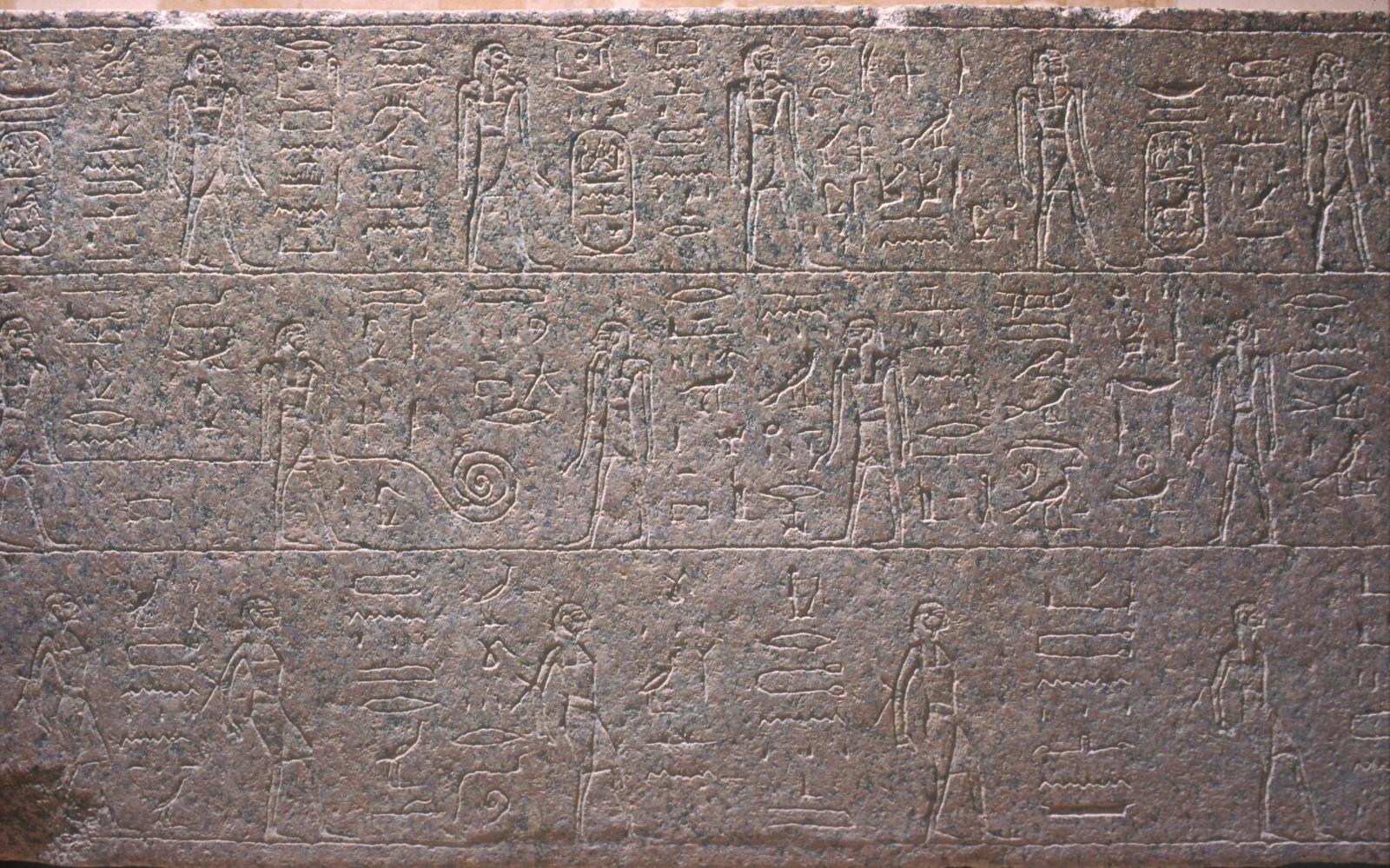
Gate I
See entire tombThe sloping floor of corridor I extends upwards through this gate into the floor of chamber H.
Porter and Moss designation:
Corridor I
See entire tombThe corridor slopes towards gate J and the burial chamber J. There is a ceiling recess at the beginning of the corridor, and in each wall at the end are two narrow vertical recesses. Only traces of texts survive where they were cut through the now-missing plaster into the stone surface beneath.
Porter and Moss designation:
Gate J
See entire tombThe lower half of the left (south) jamb has broken away flush to the wall.
Porter and Moss designation:
Burial chamber J
See entire tombThe sunken floor of the central portion of the burial chamber is flanked on the front (east) and rear (west) by a row of four pillars set in the upper level. Six steps lead down from the entrance to a sunken floor in the middle of the chamber, and another set of steps ascends to the rear upper level. A bench runs around the entire chamber and recesses and magical brick niches are spaced along the front and rear walls of the chamber. In the center of the chamber, a modern base of limestone blocks supports a second granite sarcophagus lid, surmounted by a mummiform effigy of Merenptah. Gates at the ends of the left (south) and right (north) walls lead to side chambers Ja-Jd, and a gate in the middle of the rear wall leads to chamber K.
There is a severe loss of decoration, but the eighth division (P)/ninth hour (H) of the Book of Gates is visible on the left wall. Other scenes represented are the Book of the Earth and the Book of Caverns. The vaulted ceiling has astronomical scenes including representations of deities in barks.
Chamber plan:
RectangularRelationship to main tomb axis:
PerpendicularChamber layout:
Pillared front and rear upper level, sunken central lower levelFloor:
Two levelsCeiling:
Vaulted center, flat sides
Porter and Moss designation:
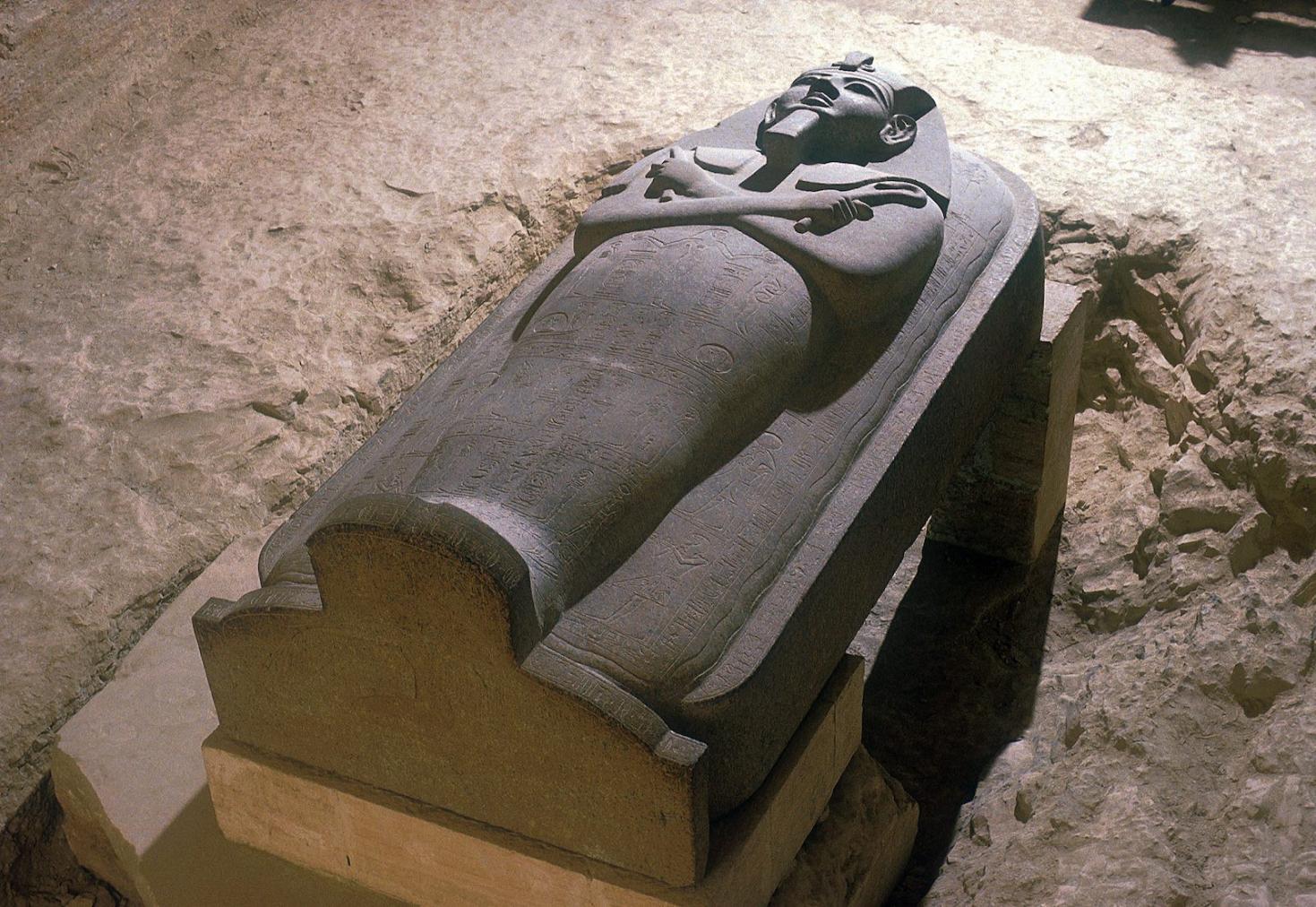
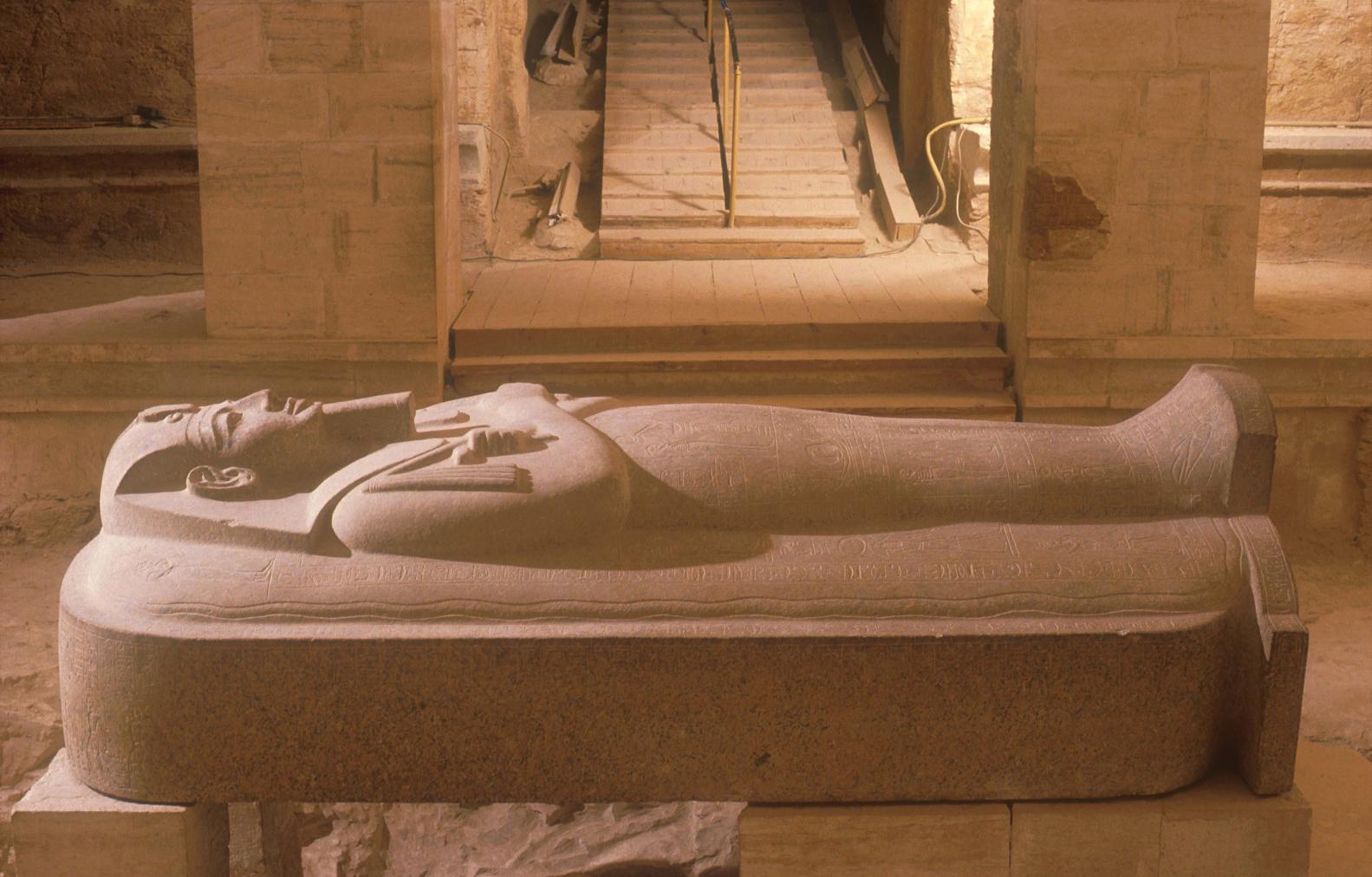
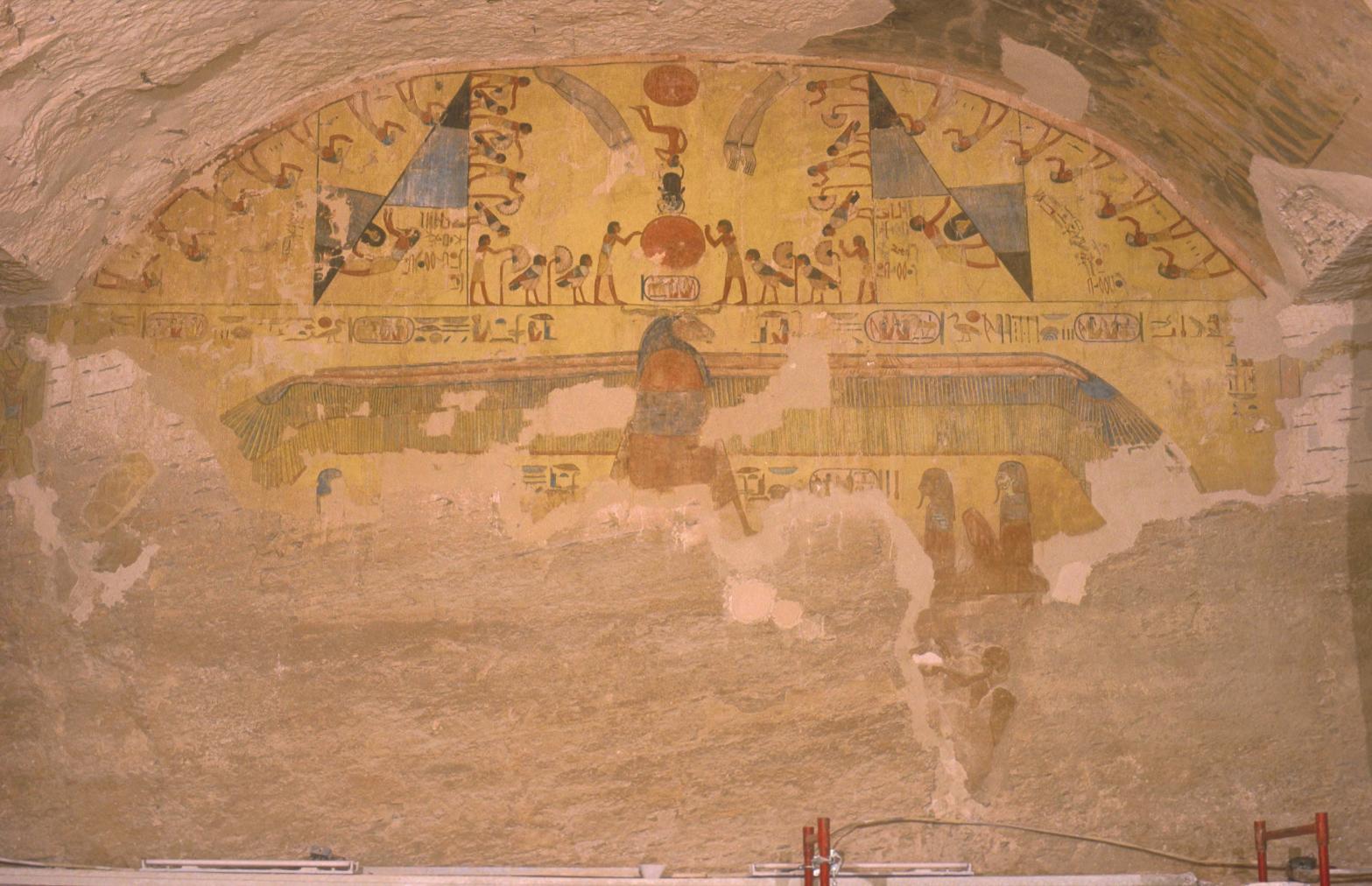
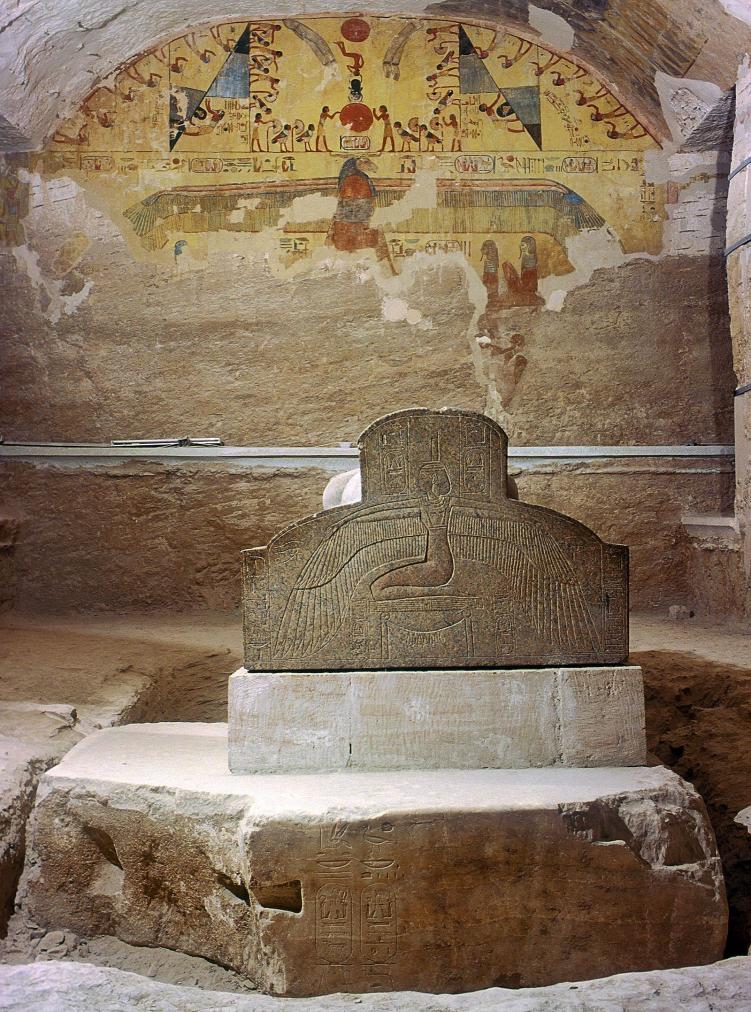
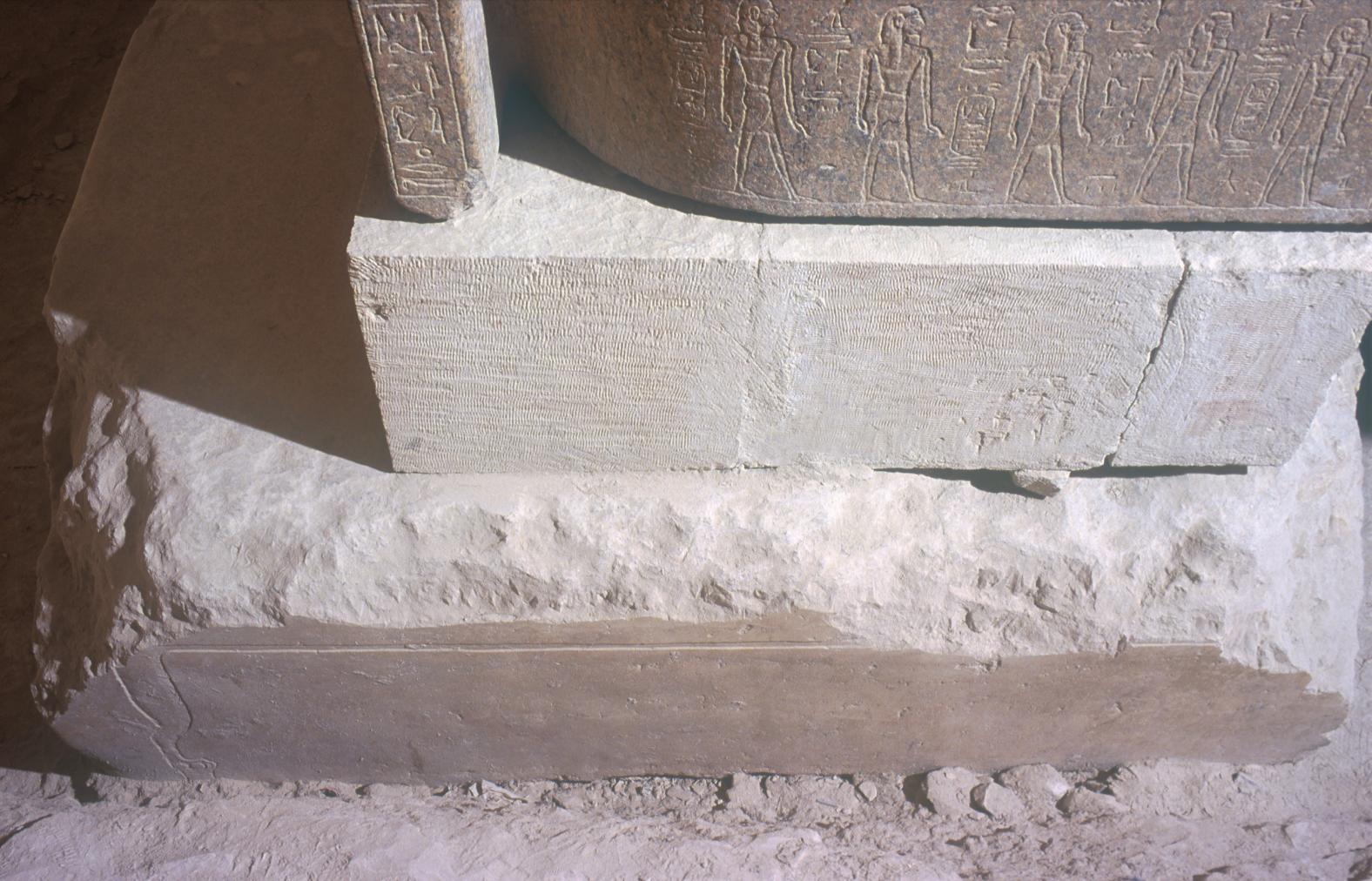
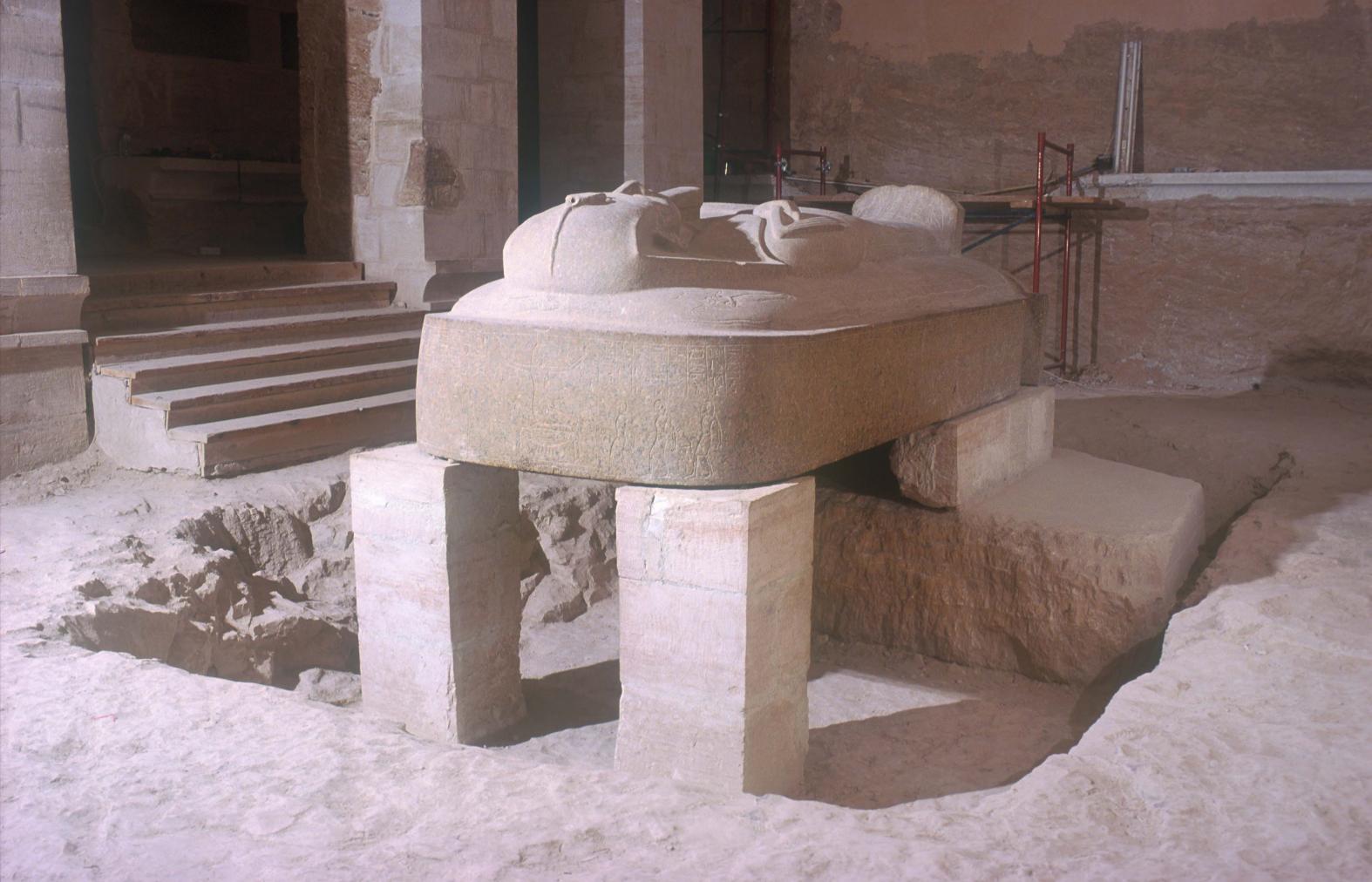
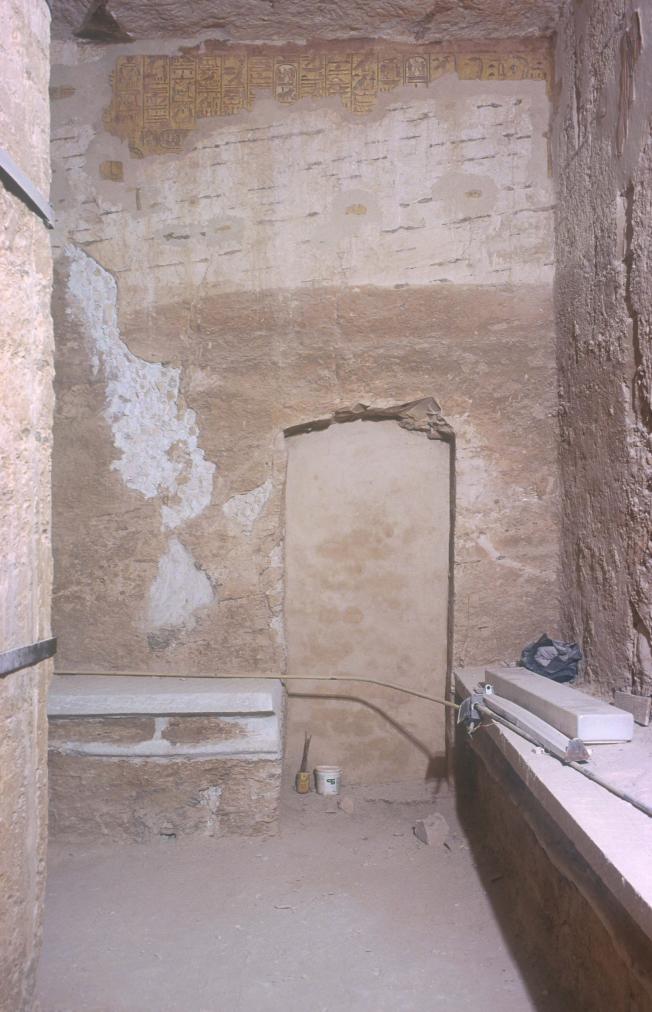
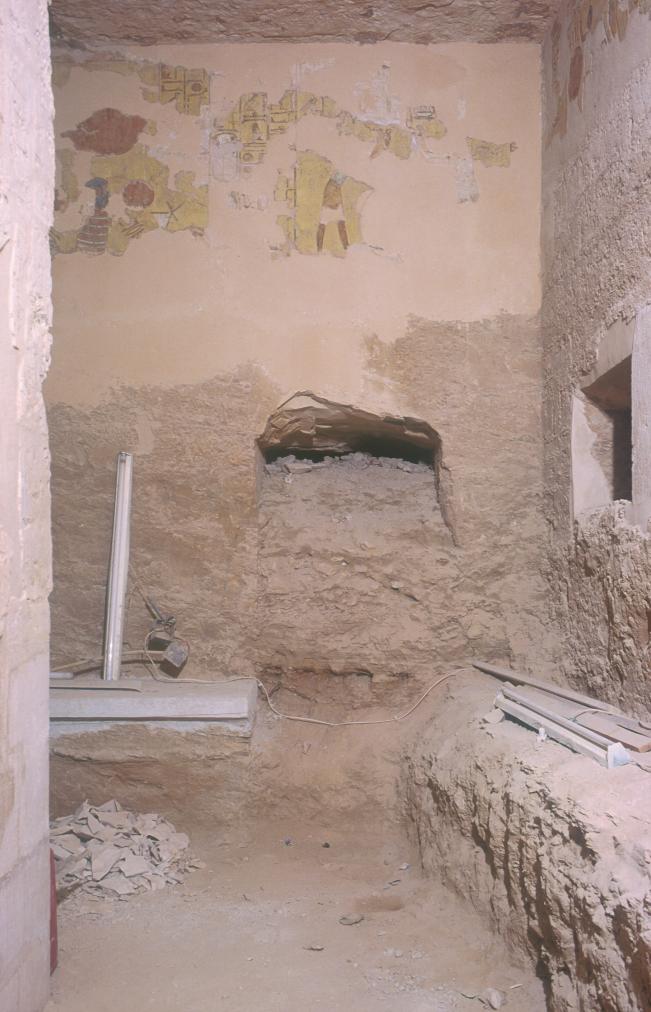
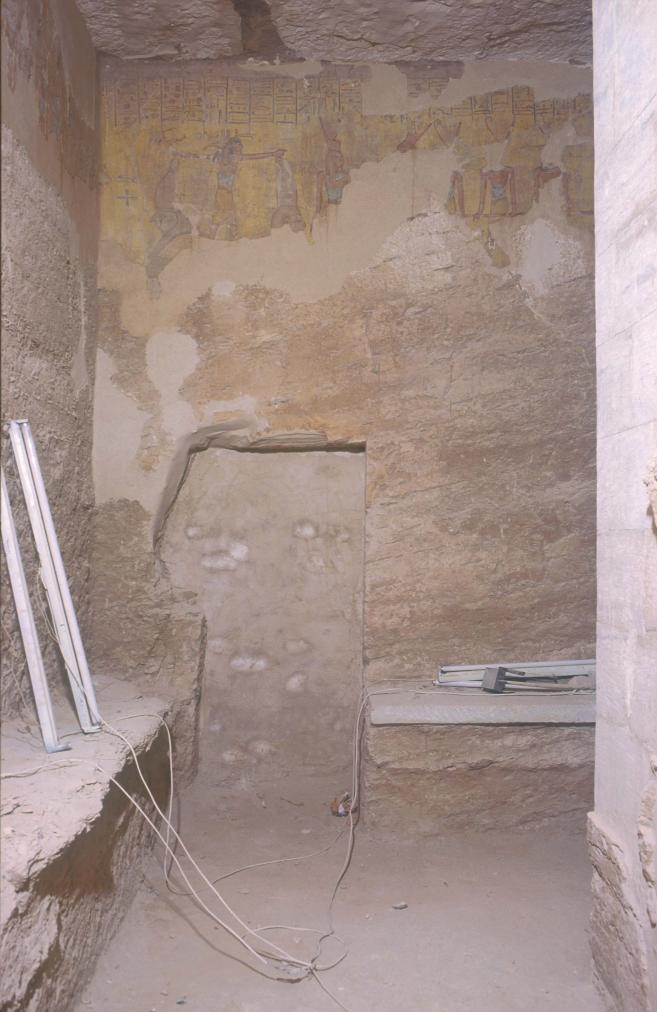
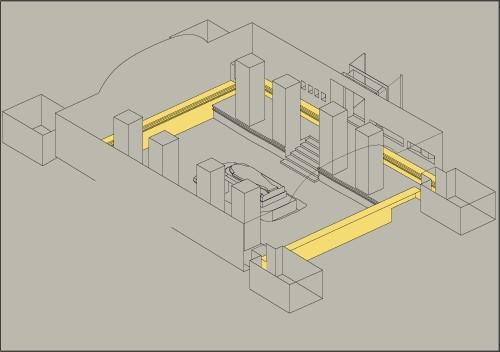
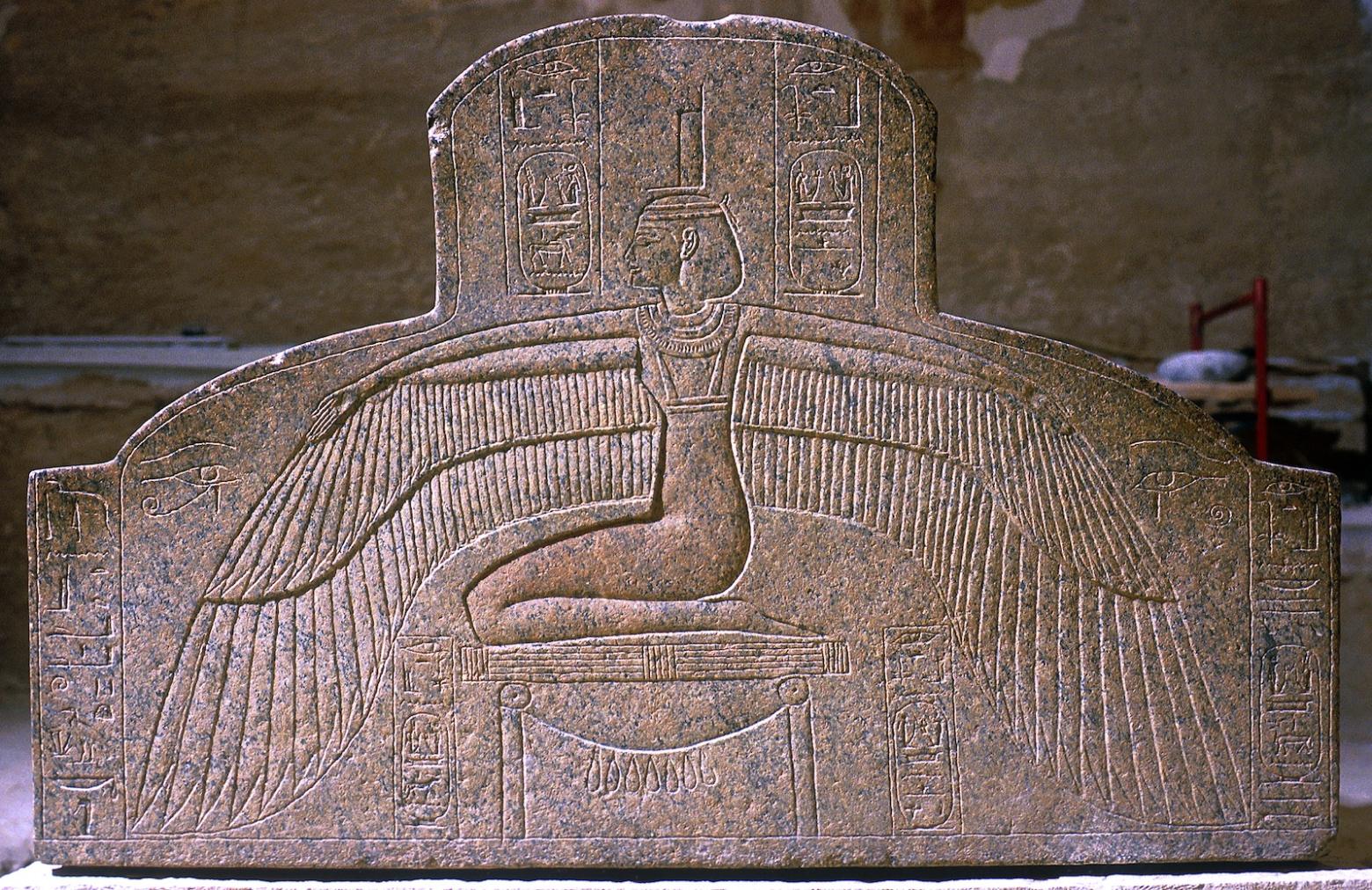
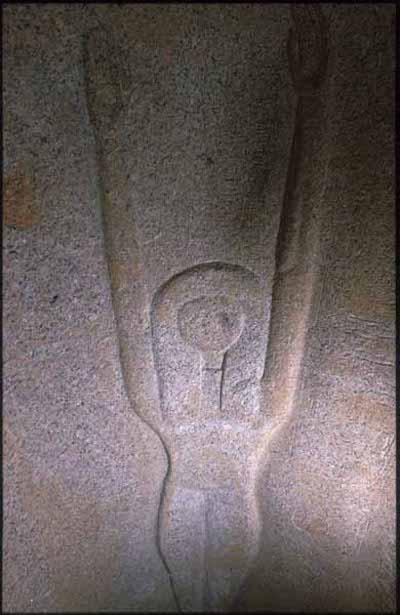
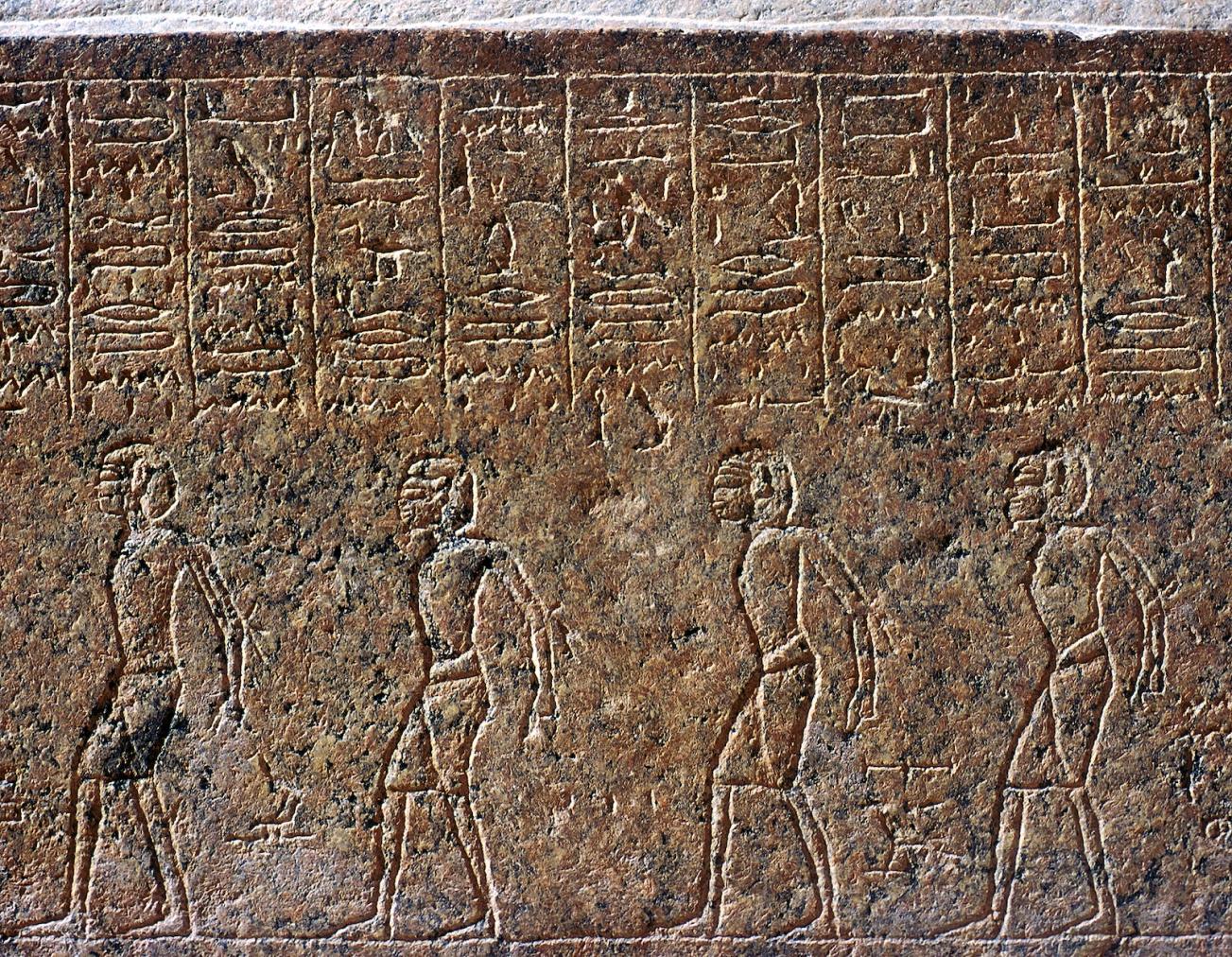
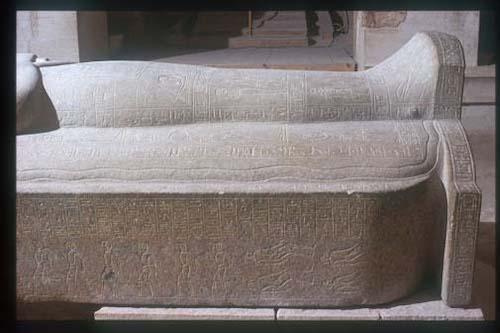
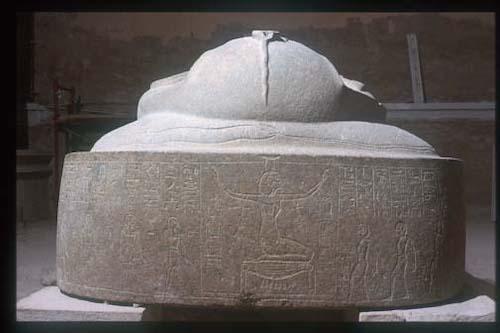
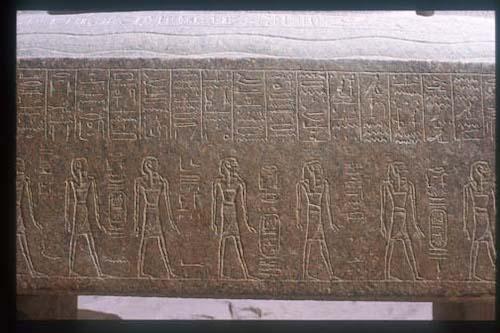
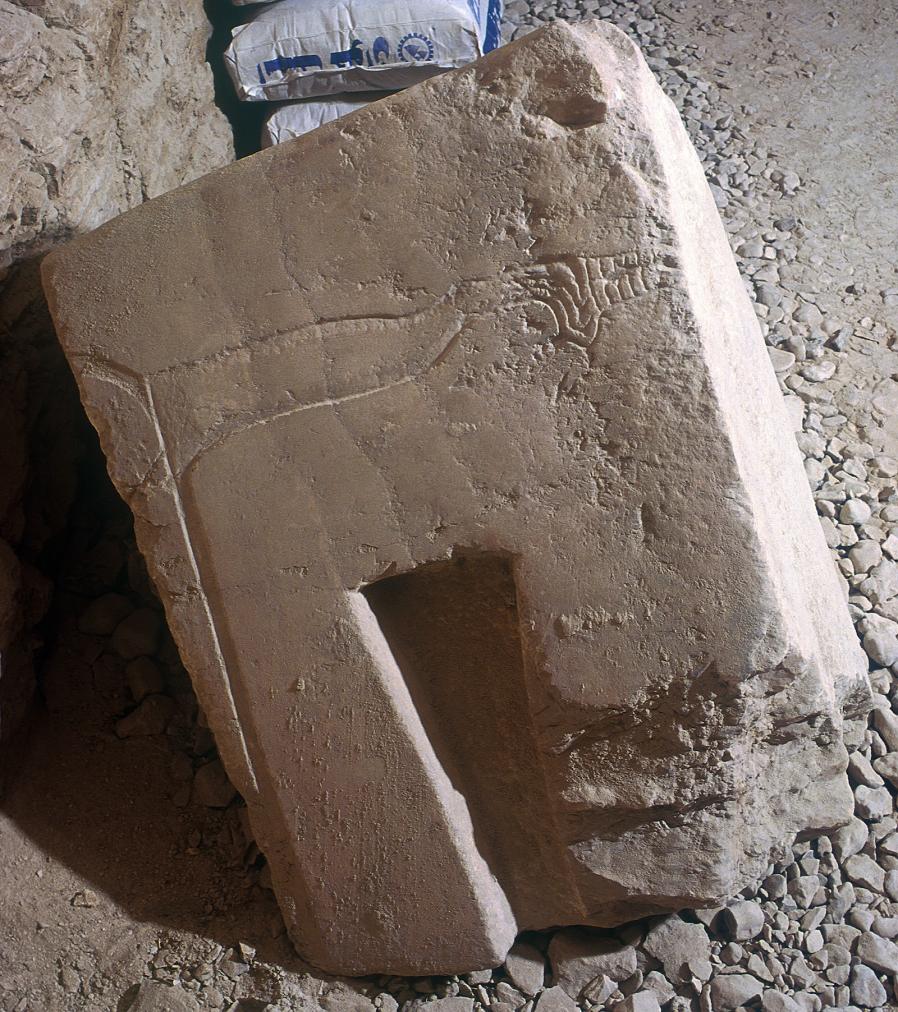
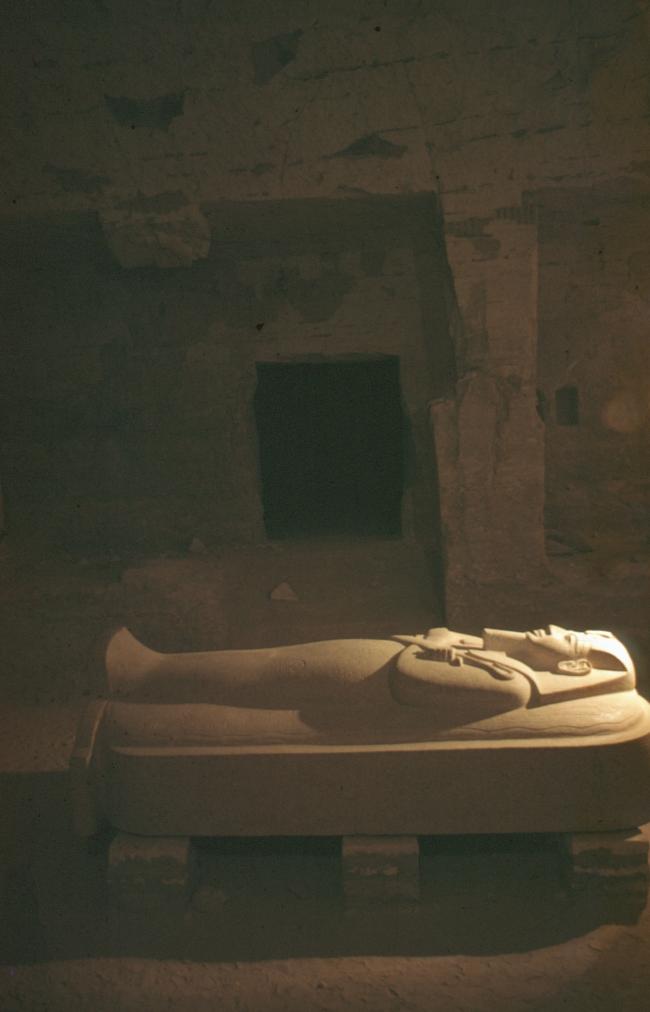
Gate Ja
See entire tombThe gate leads into side chamber Ja. It is filled with debris deposited by floods and the jambs are badly cracked.
Side chamber Ja
See entire tombThis side chamber lies off the southeast corner of the burial chamber, and is filled with dirt and stone chips deposited by floods. Evidence of a recess in the center of the rear (south) wall can be seen above the debris fill. The ceiling is flush with the soffit of the gate.
Gate Jb
See entire tombThe gate cuts through the ledge on the south wall and leads into side chamber Jb. The jambs are damaged.
Side chamber Jb
See entire tombThis side chamber is located off the southwest corner of the burial chamber, and is now filled with dirt and stone chips. The ceiling is flush with the soffit of the gate.
Gate Jc
See entire tombThe gate is blocked and sealed with a cement covering.
Side chamber Jc
See entire tombThis side chamber located to the northwest of the burial chamber is presently inaccessible, due to modern cement blocking the gate. It is thought that material such as granite fragments from Carter's clearance may be stored here. The ceiling is 8 cm (3 inches) above the soffit of the gate.
Gate Jd
See entire tombThis gate is now blocked and sealed.

Side chamber Jd
See entire tombThis side chamber to the northeast of the burial chamber is inaccesible. It has been reported that artifacts found in Carter's clearance are stored here. The ceiling is 8 cm (3 inches) above the soffit of the gate.
Gate K
See entire tombThe gate has suffered damage from flooding.
Chamber K
See entire tombChamber K continues along the axis of the tomb beyond the burial chamber. Traces of painted plaster decoration can be seen on the wall near the ceiling, but not enough survives to identify any decorative themes. A side chamber opens off each side near the entrance, and a third chamber opens off the rear (west) wall.
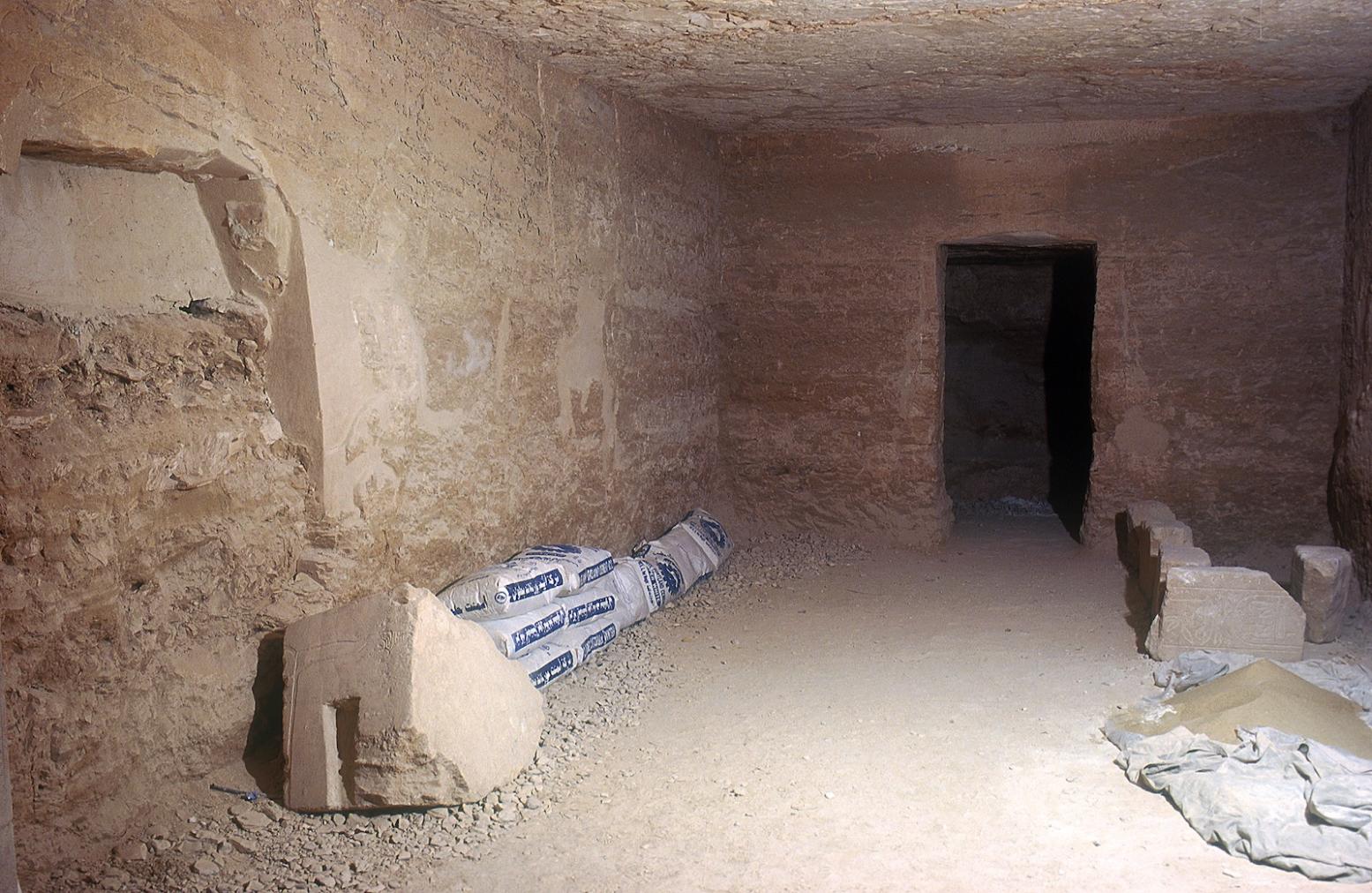
Gate Ka
See entire tombThe gate is filled with flood debris and its jambs are badly damaged.
Side chamber Ka
See entire tombThis chamber is set at a right angle to the main axis and lies off chamber K. It is full of flood debris.
Gate Kb
See entire tombThe gate leads into side chamber Kb.

Side chamber Kb
See entire tombThis small side chamber has roughly carved walls with no trace of decoration.
Side chamber Kc
See entire tombThe chamber is full of flood debris.
Gate Kc
See entire tombThis chamber is set at a right angle to the main axis and is situated off chamber K. It is full of flood debris and exhibits a significant loss of decoration.

About
About
The tomb of Merenptah, KV 8, is located off the main Wadi. Three sloping corridors (B, C, D) lead to a well chamber (E) and pillared chamber (F) with side chamber (Fa). A central descent (F) and sloping corridor (G) lead to a chamber (H) beyond which a second corridor (I) slopes down to the vaulted burial chamber J. This has side chambers (Ja-Jd) in the corners and a chamber (K) at the rear also with side chambers (Ka-Kc). The jambs of all the gates from B to H were cut back during the later stages of tomb construction and replaced with sandstone blocks.
The tomb is decorated with scenes from the Litany of Ra (corridor B, corridor C), Book of Gates (gate C, corridor C, pillared chamber F, burial chamber J), Imydwat (corridor C, corridor D, gate E), Book of the Dead (corridor C, chamber H), Opening of the Mouth ritual (corridor G), Book of the Earth (burial chamber J), Book of Caverns (burial chamber J), as well as pictures of the deceased and deities (corridor B, well chamber E, first pillared chamber F, chamber H, burial chamber J). Flooding badly damaged the pillars in burial chamber J. Most of the scenes beyond pillared chamber F have been destroyed except for those high on the walls and ceiling of burial chamber J.
Noteworthy features:
Burial chamber J has several unique features. There are multiple niches in the front and rear walls of the chamber, and Merenptah originally rested inside a set of four stone sarcophagi. In order to bring the sarcophagi into the tomb, door jambs were cut away and later replaced by sandstone blocks.
Site History
During the later stages of the tomb's construction, door jambs from entryway A to chamber H were cut away, probably to make room for the descent of the massive granite Sarcophagus. The jambs were then replaced with inscribed sandstone blocks keyed into place with dovetail cramps. The cramps fit into slots atop the blocks, which were installed in the bottoms of recesses where the original jambs had stood. None of these blocks were apparently found in their original locations, but some were found in the fill of the Well shaft, and on the floor of burial chamber J. Perhaps at this time the rear two pillars in pillared chamber F were also removed.
Parts of the tomb lay open at various later periods. Following the removal of the plundered mummy for reburial in KV 35, an effort was made to re-use pieces of the sarcophagus. The first and second sarcophagus boxes were broken up and the the third granite sarcophagus was moved to Tanis. In the process, the well shaft was filled in, and this allowed later floods to carry debris into the bottom chambers of the tomb. We know that upper chambers of the tomb (up to pillared chamber F) were accessible during Greek and Roman times because of the 135 graffiti written on the walls.
Dating
This site was used during the following period(s):
Exploration
Conservation
Conservation History
Recent conservation efforts by the Supreme Council of Antiquities have covered over the breaks in the corridor walls and ceilings, and covered over the scars from the cutting back of the original door jambs. The position of the replacement jambs was reconstructed in cement.
Site Condition
KV 8 is one of many tombs in the Valley of the Kings that has been damaged by flash floods. Most of the tomb has been excavated, but the side chambers off the burial chamber are still full of debris, as are parts of the side chambers off chamber K. Aside from damage to pillars in burial chamber J, the tomb itself has not suffered any structural damage except for the door jambs, dismantled in ancient times during the installation of the Sarcophagus. Most of the scenes beyond pillared chamber F were destroyed, except for the higher walls and ceiling of burial chamber J. The paint and plaster that survived the floods are in good condition.
Hieroglyphs
Merenptah
 King of Upper and Lower Egypt, Ba-Soul of Ra, Beloved of Amen, Son of Ra, Beloved of Ptah, Satisfied with Justice
niswt-bity bA-n-Raw mry-Imn sA-Raw mry-n-PtH Htp-Hr-mAat
King of Upper and Lower Egypt, Ba-Soul of Ra, Beloved of Amen, Son of Ra, Beloved of Ptah, Satisfied with Justice
niswt-bity bA-n-Raw mry-Imn sA-Raw mry-n-PtH Htp-Hr-mAat




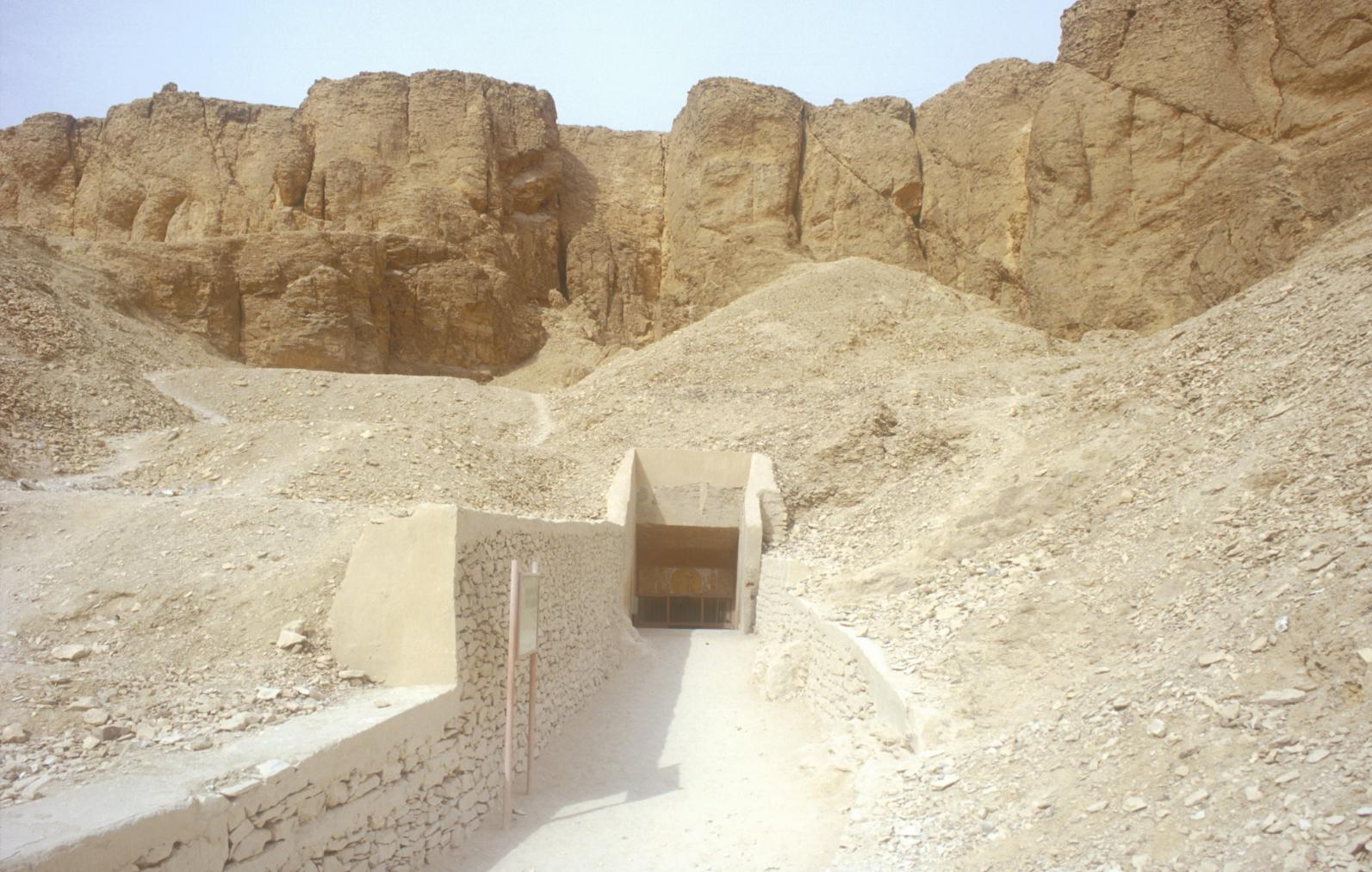























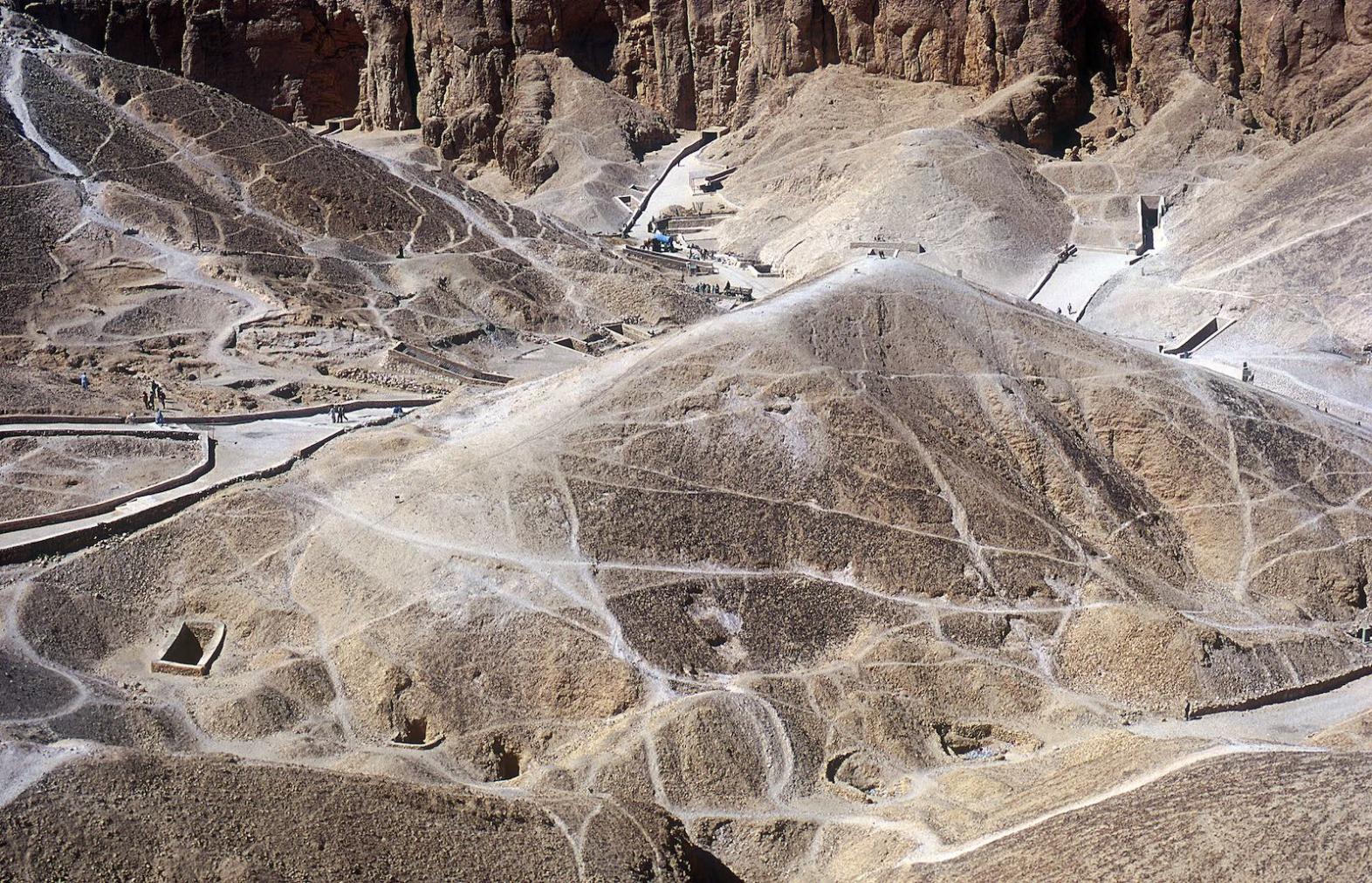
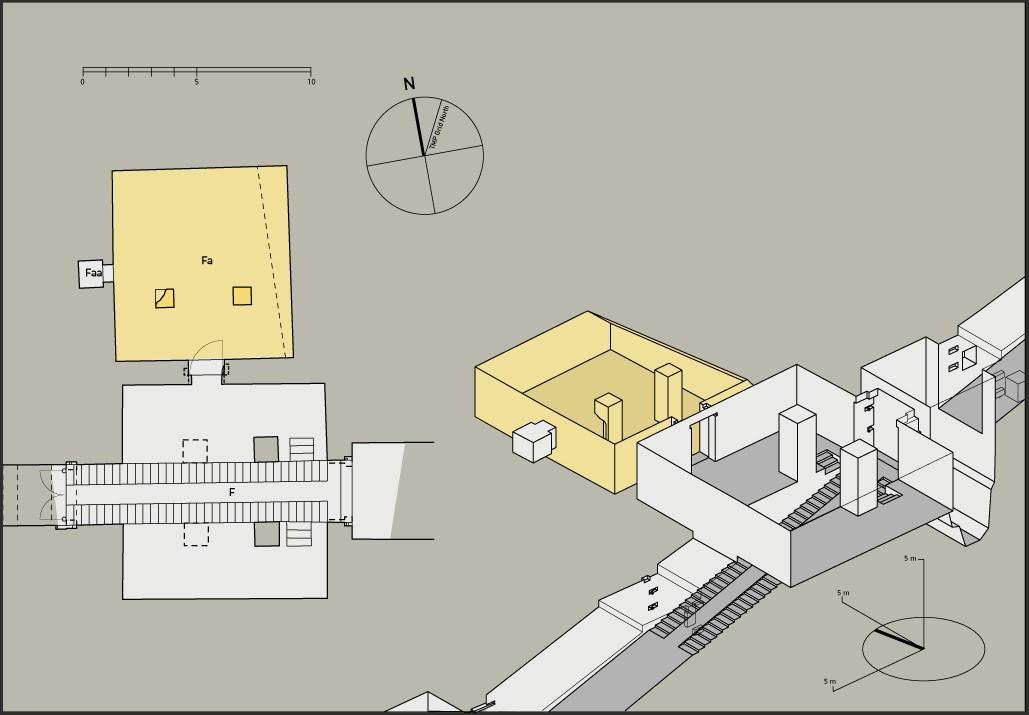





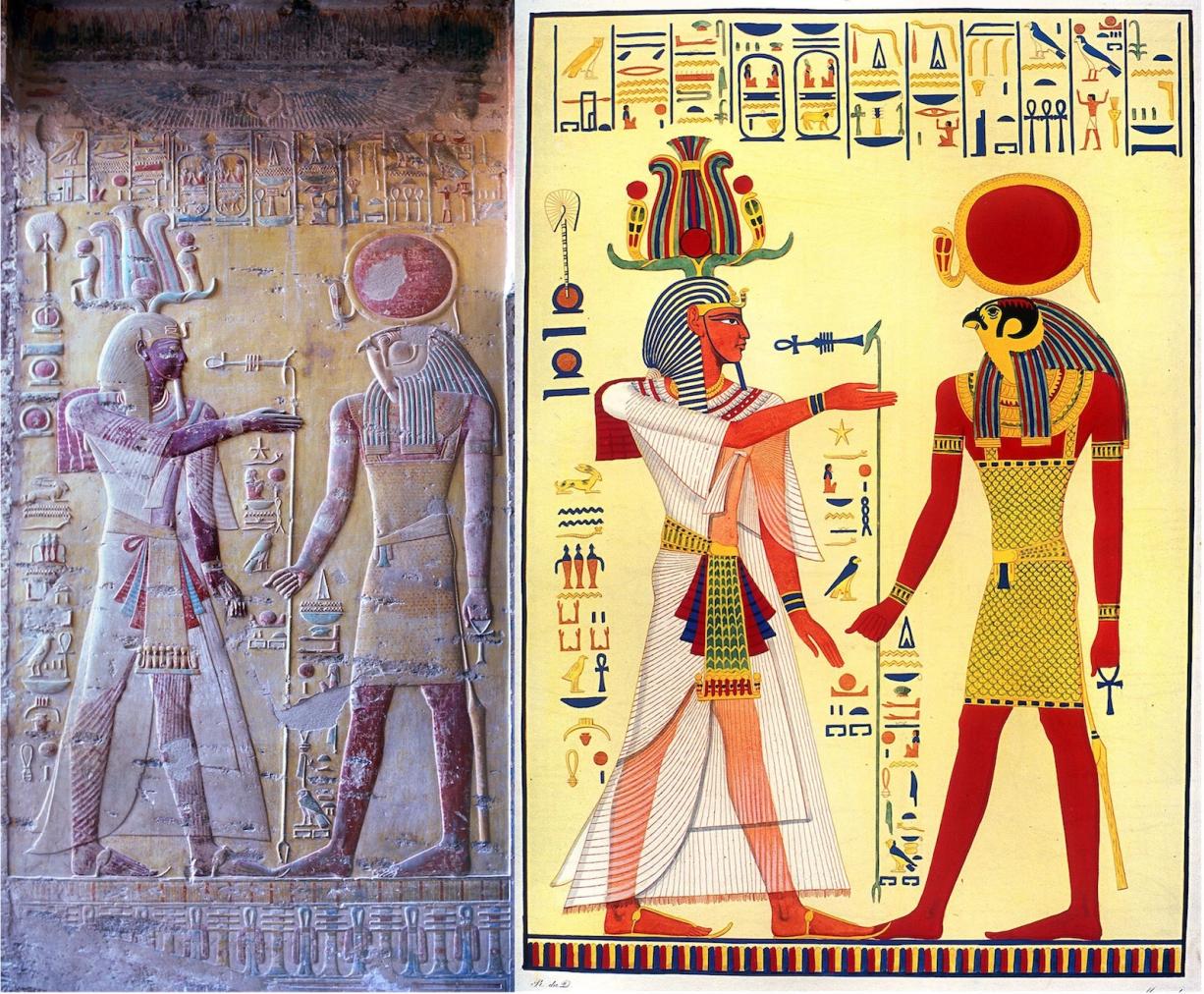
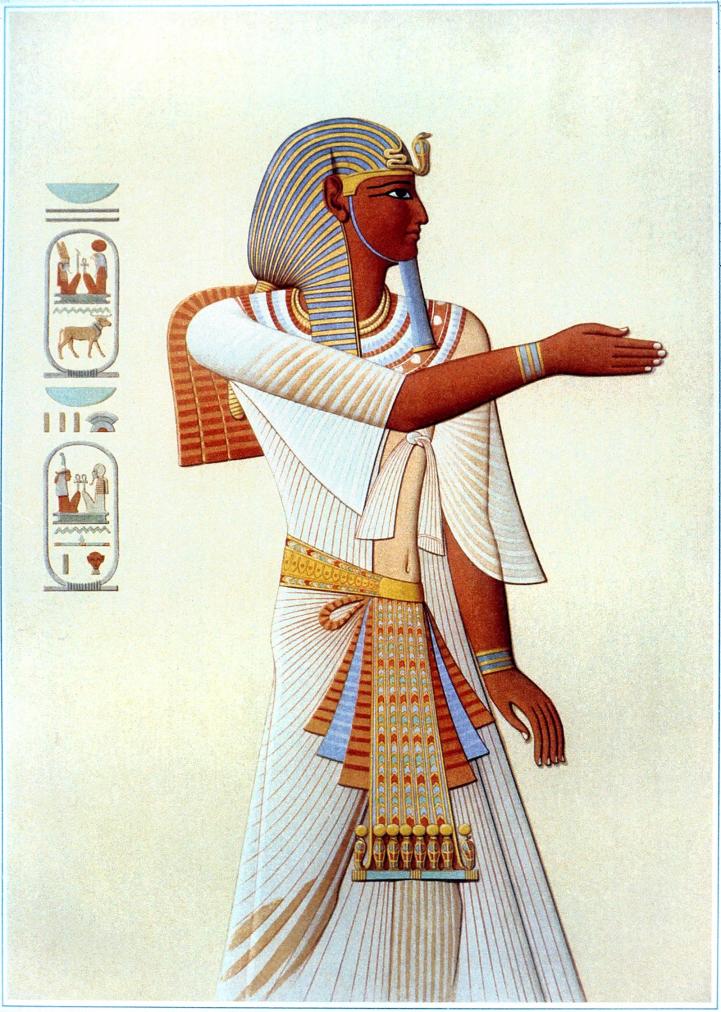
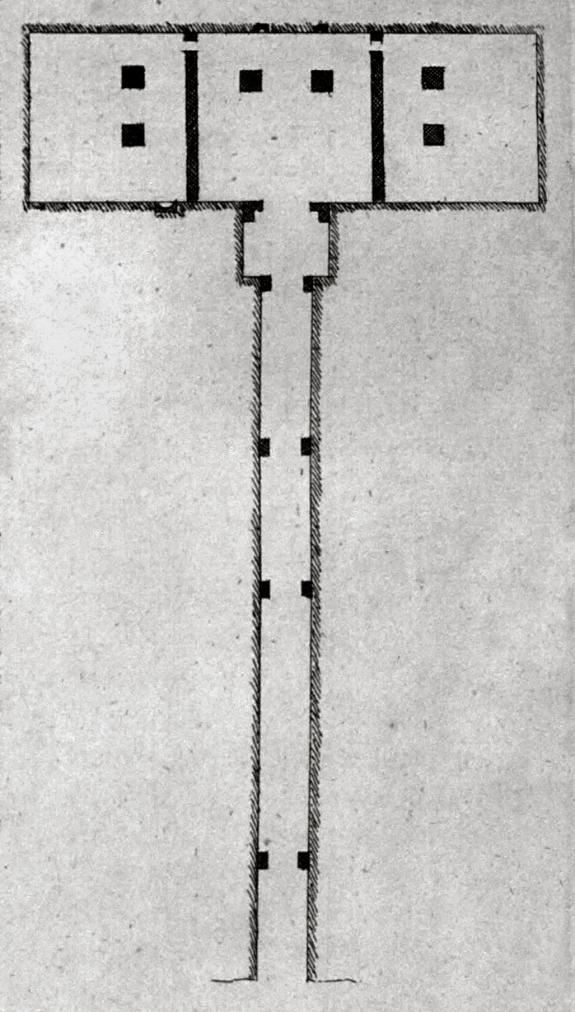
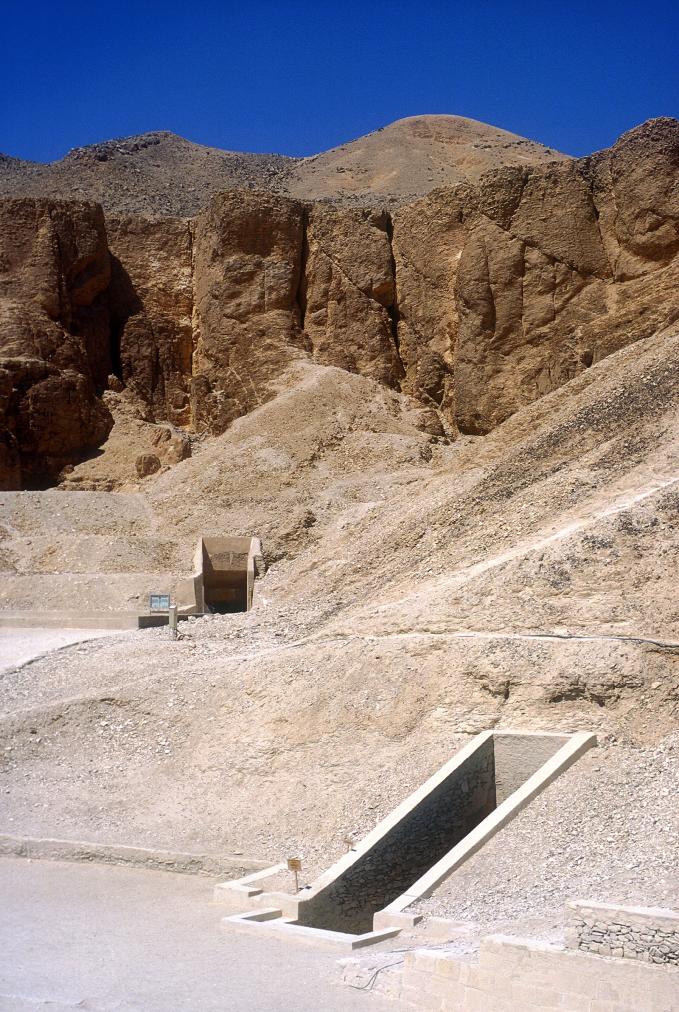
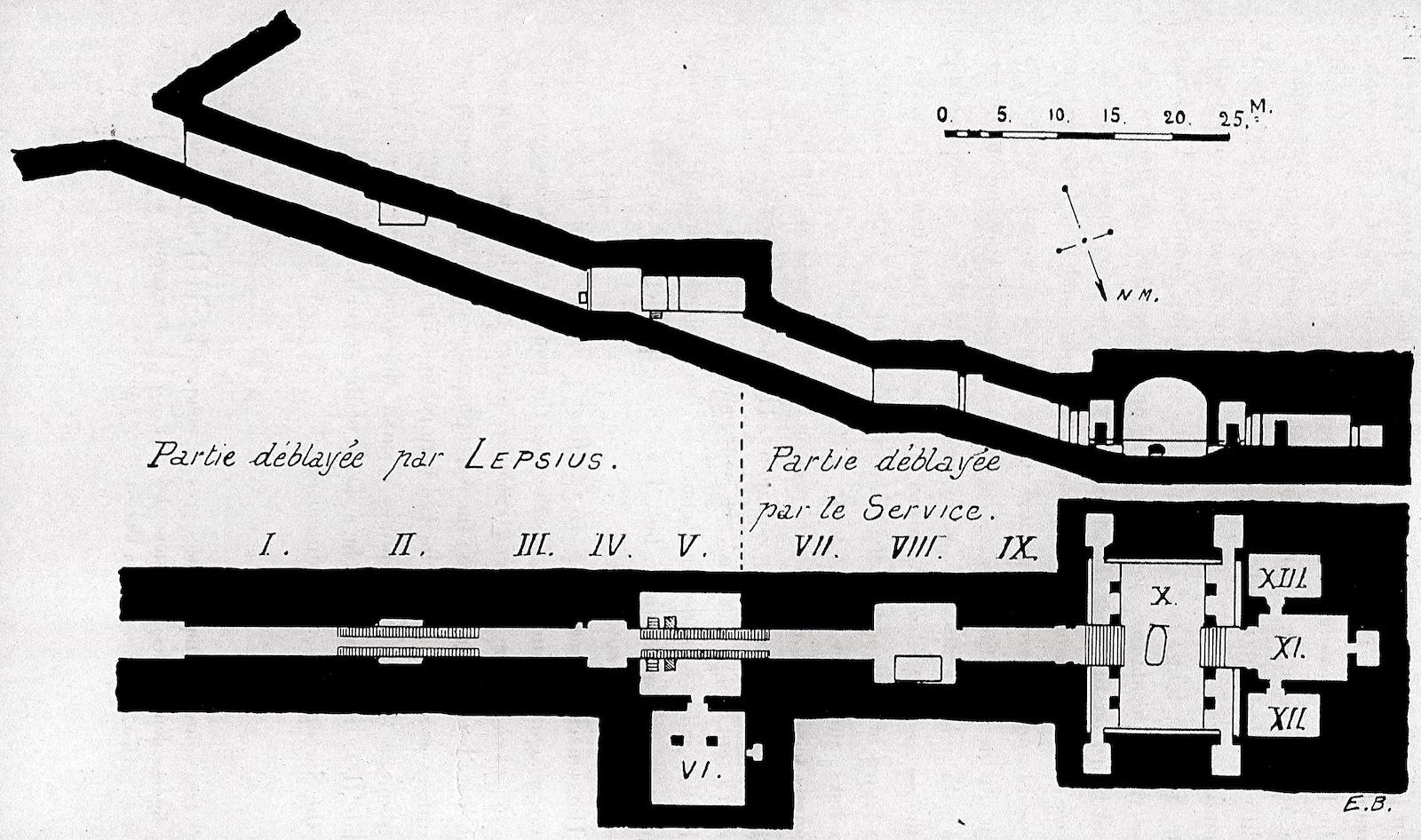

















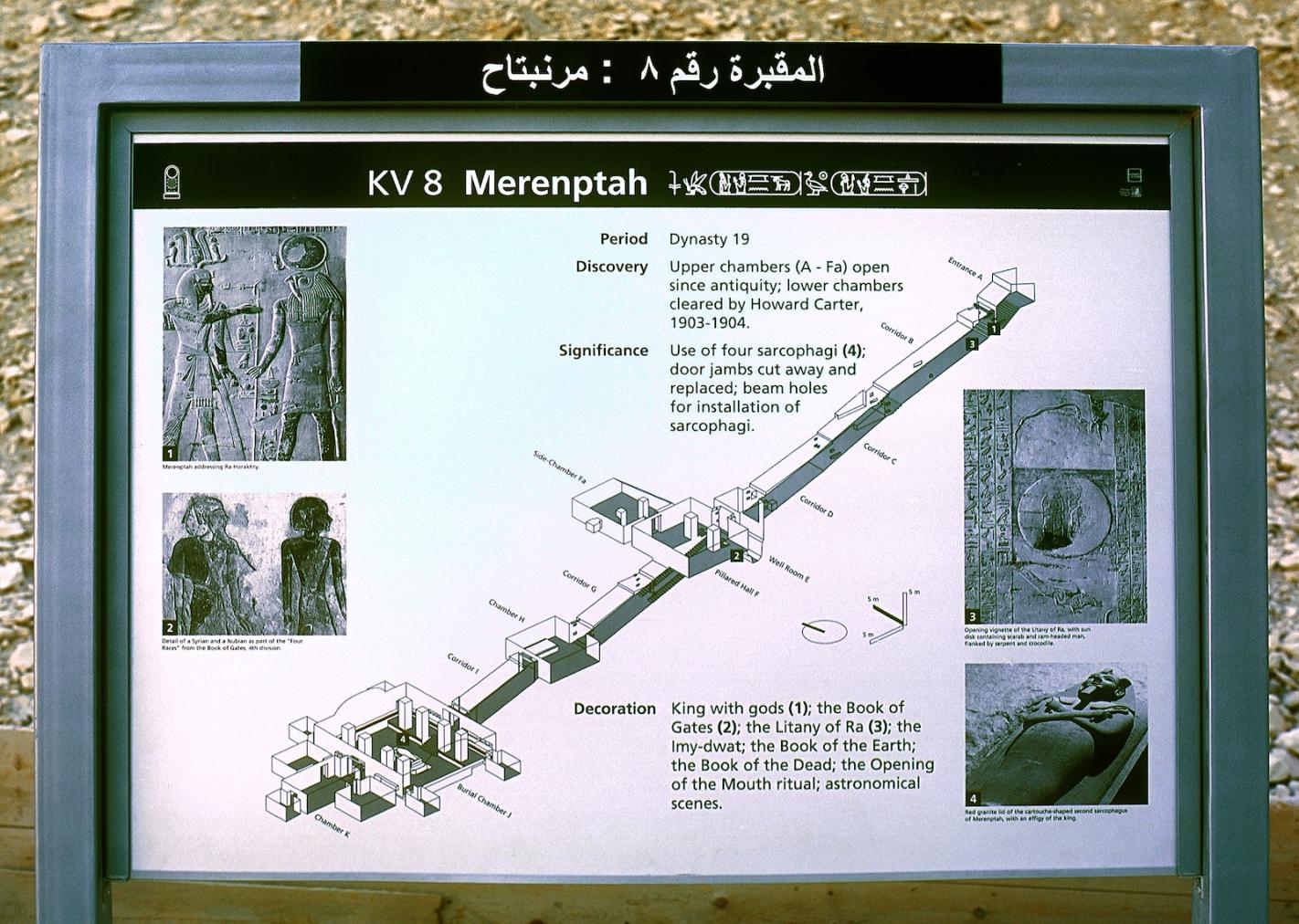








Articles
Historical Development of the Valley of the Kings
History of the Valley of the Kings: Third Intermediate Period to the Byzantine Period
Development of Tombs in the Valley of the Kings
Bibliography
Assmann, Jan. Die Inschrift auf dem äusseren Sarkophagdeckel des Merenptah. Mitteilungen des Deutschen Archäologischen Instituts: Abteilung Kairo 28 (1972): 47-74.
Aston, David. Pottery from the Valley of the Kings: Tombs of Merenptah, Ramesses III, Ramesses IV, Ramesses VI and Ramesses VII. Ägypten und Levante 8 (1998): 137-214.
Baillet, Jules. Inscriptions grèques etlatines de tombeqaux des rois ou syringes à Thèbes (= Mémoires publiés par les members de l’Institut français d’archéo-logie orientale du Cairo, 42). Cairo, 1920-1926. Three vols.
Barbotin, Christophe and Sylvie Guichard. Fouilles du Louvre Dans la Tombe de Merenptah -KV 8. Memnonia 18 (2007): 105-117.
Barbotin, Christophe and Sylvie Guichard. Fouilles du Louvre dans la tombe de Merenptah, 2005-2006. Memnonia 17 (2006): 151-169.
Barbotin, Christophe and Sylvie Guichard. La tombe de Merenptah: Projets et travaux récents. Memnonia 15 (2004): 153-164.
Brock, Edwin C. and Lyla Pinch Brock. The Merenptah Sarcophagi Restoration Project. In: Gloria Rosati, Gloria Guidotti and Maria Cristina Guidotti (eds.). Proceedings of the XI International Congress of Egyptologists, Egyptian Museum, Florence, 23-30 August 2015. Oxford: Archeopress, 2017. Pp. 59-63.
Brock, Edwin C. A Puzzle of Pharaonic Proportions. Egyptian Archaeology: The Bulletin of the Egypt Exploration Society. London. 9 (1996): 31-32.
Brock, Edwin C. Piecing it all Together: An Ongoing Study of Later New Kingdom Royal Sarcophagi. KMT 2, 1 (1991): 42-49.
